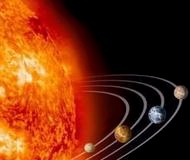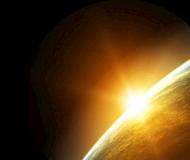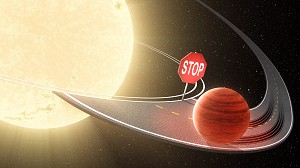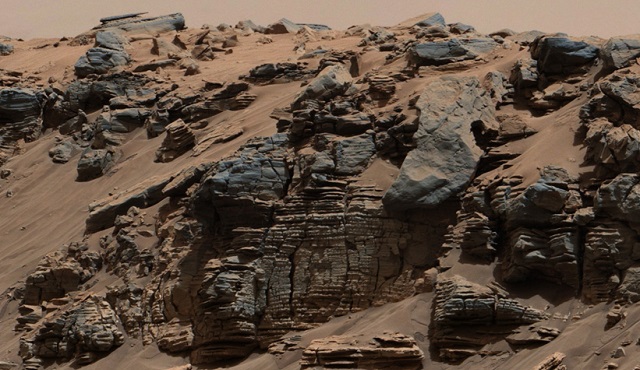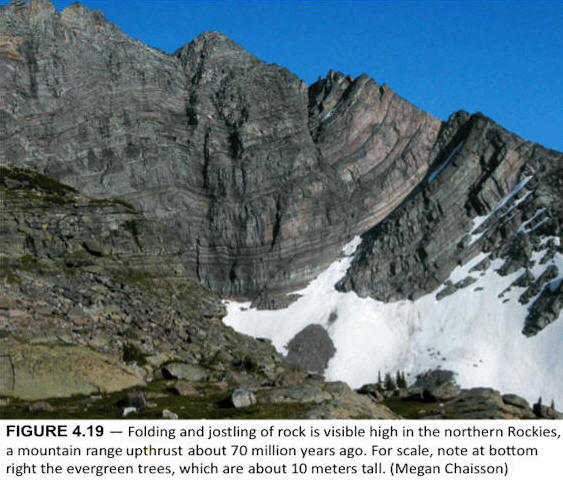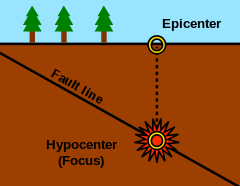
| The Second Sun Report (Full Report) |
|
|
The Full Report in a Single Page |
|
|
The Report by Parts |
A study shows that there was a second sun (star) in the solar system used to orbit in the asteroid belt, between Mars and Jupiter, around 200 million years ago.
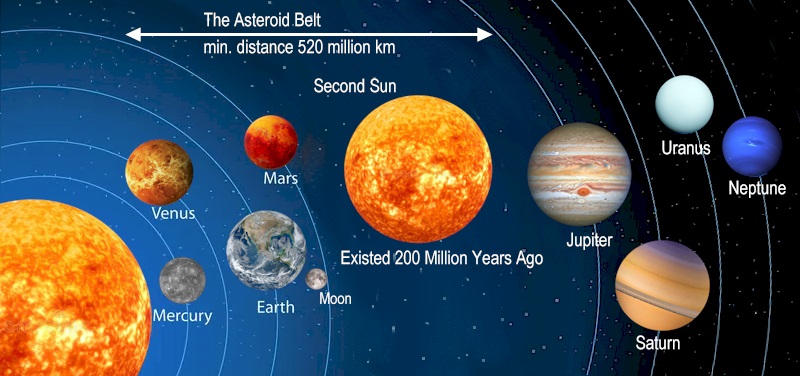
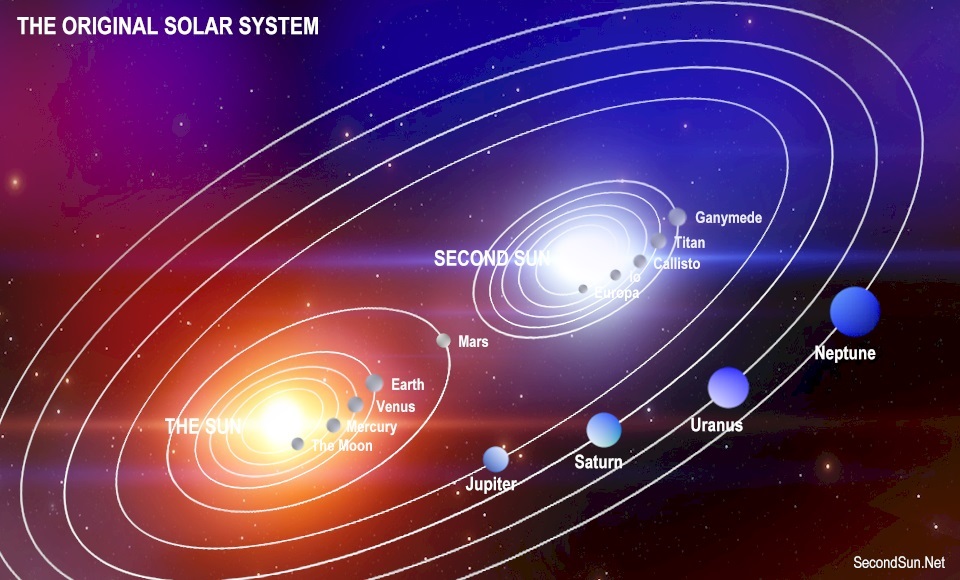
Published: January 15, 2014
Last Updated: September 10, 2019
![]()
![]() This
page contains the full report.
This
page contains the full report.
To read the report by parts click here
![]()
Summary and Overview
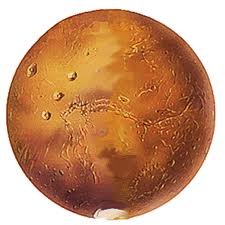
Have you ever wondered why Mars is red, covered with a layer of iron oxide (rust), and why it is polluted with radioactive materials?
Isn't it true that some dying stars produce iron oxide?
It is also true that radioactive materials are products of dying stars.
Could it be that Mars was neighboring to a star that is not in existence today?!
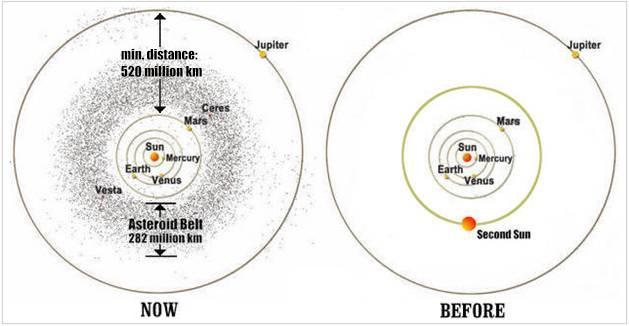
The picture above says it all. A second sun was in the sky around 200 million years ago! Some of its remains are found now in the main asteroid belt. It was a very huge sun, bigger and hotter than the current sun.
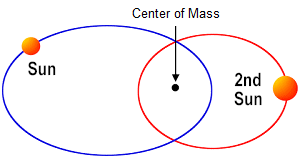
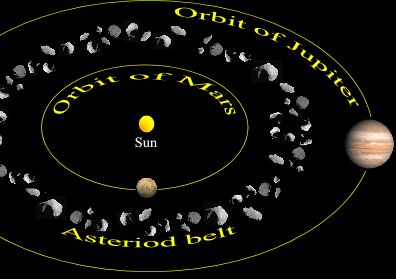
However, the orbit of the second sun, when it was fully functioning, before losing the most of its mass, most likely was different from the picture above, maybe as in the picture to the right.
The dominant theory for the asteroid belt is that the rocks and metals that are orbiting in the belt now are leftover materials, failed to come together to form a planet. Another suggestion says that there was a planet in that orbit, collided with another object and broken apart. And both of these two theories do NOT take anything outside the asteroid belt into account!
Now if we assume a space object used to orbit in the asteroid belt, and we look at it from the impact that it has left on the planet Mars in particular, and the whole solar system in general, that object cannot be anything but a star!
It is true that putting all the objects in the asteroid belt together will "not" make them a big star, and not even a small star in the size of the moon, but the objects themselves are remains of a star, signs of a star.
The solar system is no exception: "Our planet
was born as a ball of rock orbiting a single star. Or was it? New research from
UC Berkeley and Harvard University suggests that
almost all stars are born in pairs, including our own." (popularmechanics.com)
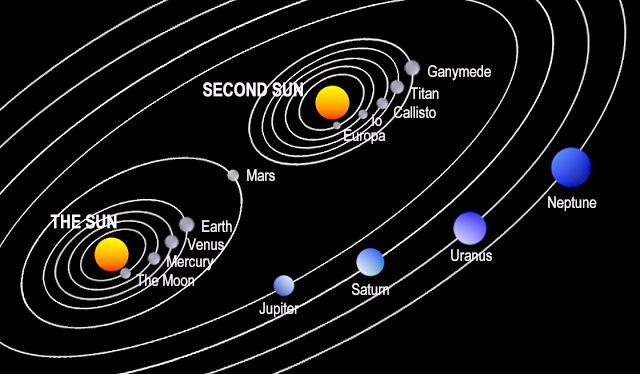
The picture above shows how the solar system was when the second sun was
fully functioning. Each sun has five planets. The closer the planet to the sun,
the smaller it is. Mars is smaller than Earth because there was a second sun on
the other side. Jupiter was the smallest gas planet... In paragraphs to follow,
we will talk about each part of this picture in detail.
"according to oxygen isotope records, early Earth
surface temperatures could have been as high as 45 – 85 degrees C!"
atoc.colorado.edu
On the other hand, it is said that the early Sun was cool, giving only about 70% of solar heat, or even less. What was the source of that extra heat?
Because the second sun was bigger and much hotter than the existing sun, it ran out of fuel much faster.
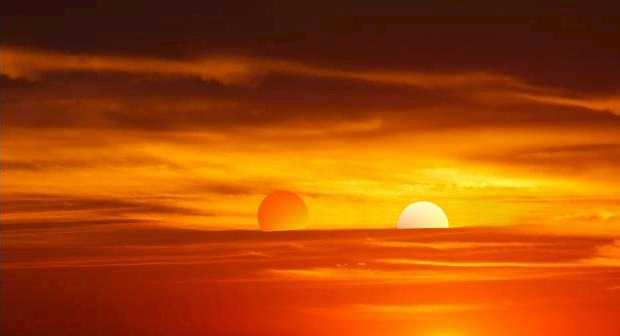
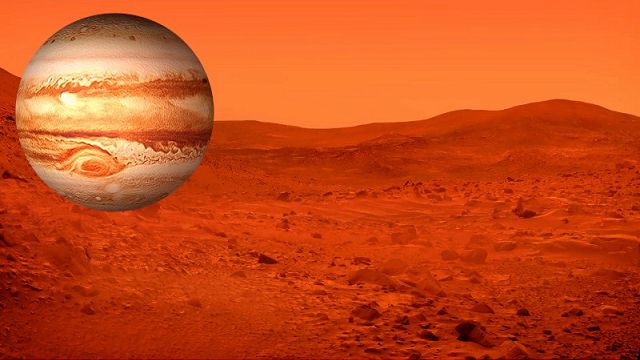
The red surface in the picture above is the surface of Mars; the spherical planet on top of it is Jupiter.
Mars is called the red planet because it is covered in rust.
Jupiter's Red Spot and the red brown shades could be rust and dust, but it hasn't been confirmed yet: "The source of its reddish color has not yet been established" (space.com)
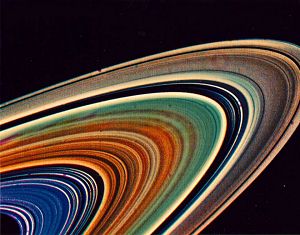
spaceplace.nasa.gov
Many scientists, based on data released by space agencies, think that the
rings of Saturn contain rust, iron oxide: "They [Saturn's rings]
extend from 6,630 km to 120,700 km above Saturn's equator, and are composed of
silica rock,
iron oxide, and ice particles ranging in size from specks of dust to the
size of a small automobile."
phys.org
In the section about the rust on Mars, we will see that the inner planet that is closer to the asteroid belt, the more percentage of rust it has on its surface, and this shows that the source of rust was very close to Mars, specifically between Mars and Jupiter, and as we move away from Mars toward Mercury, the amount of rust decreases.. The picture below summarizes the result. The percentage of rust on the surface of Venus is not known.

Percentage of rust on the surfaces of the inner planets
The same result must be true for the other side, as we move from Jupiter
toward Saturn, but the space technology in the present time is incapable of
knowing what is in these planets accurately to confirm the expectations.
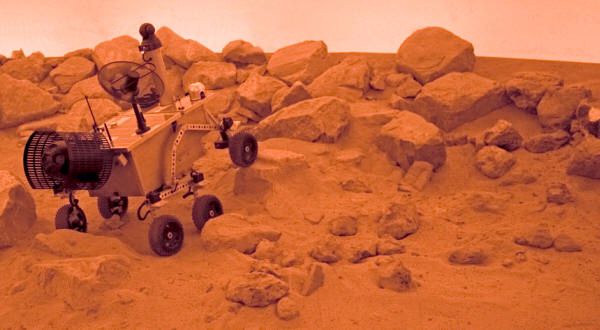
| Supernova Explosion | |
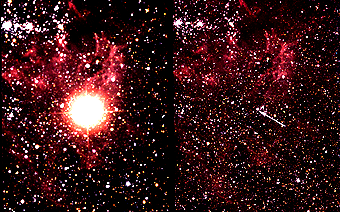 |
|
| After Explosion | Before Explosion |
| imagine.gsfc.nasa.gov | |
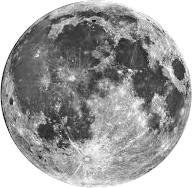 |
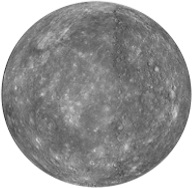 |
| The Earth's Moon | Mercury |
And if it were a planet, where was it initially?
Is it a coincidence that the moon and Mercury have very similar surface features, atmosphere and size; or that is due to the same environment the two objects have lived in for a very long period of time?
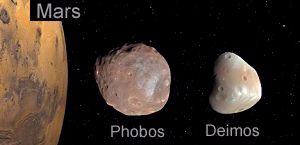
Not all moons are the same: some have the exact same features as planets, like the Earth's moon; while others are simply stones, like the moons of Mars. The total number of planet-like moons in the solar system is six, the Earth's moon is one of them, the other five used to be planets of the second sun, four of them are orbiting Jupiter now (Europa, Io, Callisto, Ganymede), and one moon is orbiting Saturn, the moon Titan.
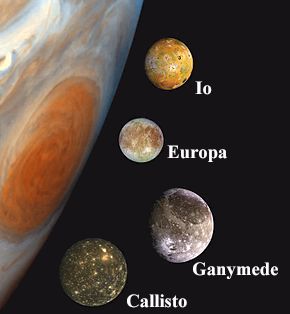
The planet Jupiter is still in a gas form because it is far away from the sun; but why are the spherical moons of Jupiter very much similar to the inner terrestrial planets? These moons have mountains, lowlands, highlands and a mantle; what else do they need to be classified as planets? To orbit a star? That is the only thing they are missing now.
The moon of Jupiter Io has over 400 "active" volcanoes, it is the most volcanically active world in the solar system.
These moons must have been planets orbiting a star at some point in time. Planets form around stars, and not around other planets.
Since there are signs of a second sun in the asteroid belt, and because the moons are relatively close to the asteroid belt, we have to assume that these moons were actually planets of the second sun.
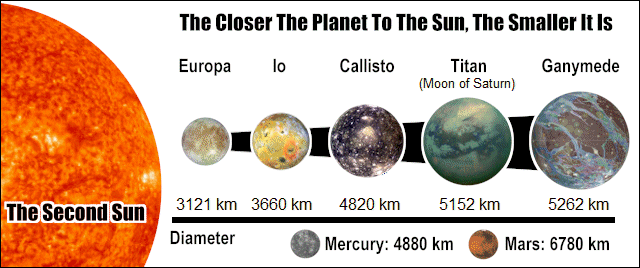
The second sun was bigger than the existing sun, so it produced more heat,
and that heat forced the nearby planets to shrink, to be smaller.
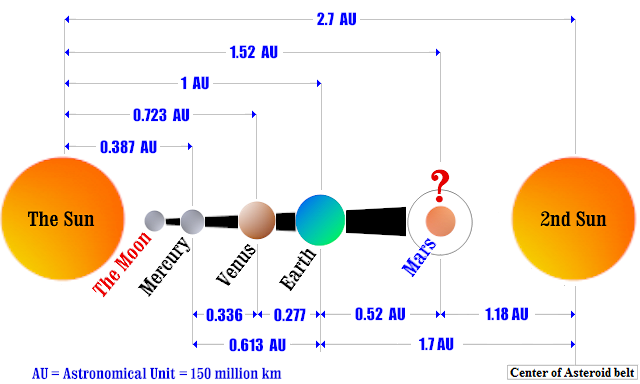
Based on the arrangement of the inner planets, we see that the closer the inner planet to the Sun, the smaller it is; and the farther the bigger. Mars is the farthest inner planet from the Sun, so it should be bigger than Earth! It is the second sun that prevented Mars from having the size that is supposed to have.
The possibility for the second sun to affect the size of Mars is when the two suns come close to each other in their elliptical orbit, as in figure C in the picture below.

Unlike Earth and Venus, the orbit of Mars now is different somehow (see the picture below). Mars must have been in this long elliptical orbit since the days of the second sun, but when the second sun was fully functioning, its gravitational pull on Mars most likely was very strong, pulling the planet all the way very near its own planets.
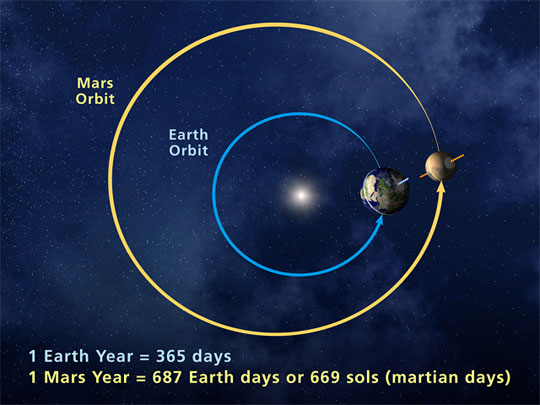
The Orbit of Mars
"Mars also has the second most eccentric orbit
of all the planets in the Solar System (0.0934), which makes it a distant second
to crazy
Mercury (at 0.20563)."
universetoday.com
Eccentric orbit value in the quote above is the number that shows how much a planet's orbit deviates from being perfect circle.. Perfect circle doesn't exist.
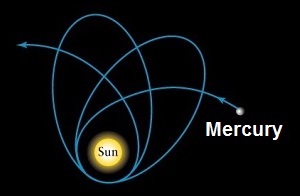
The "crazy" orbit of Mercury mentioned in the quote above is caused by a missing planet between Mercury and the Sun. That planet is currently the earth's moon, it was initially the first planet next to the sun.. More on this point in the next section, The Solar System Formation.
When Mars at its farthest point from the existing sun, it comes very close to the planets of the second sun, as in the picture below. This is where the second sun affected Mars and prevented it from having the size that it should have.

The Gas Planets:
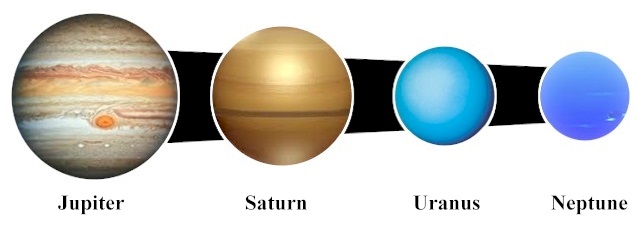
Gases from the dying second sun attracted to gas planets and increased their gas volume.
Unlike the inner planets, the sizes of the gas planets are in reverse order: the planet that is closer to the Sun, the bigger it is; not just bigger, but too much bigger! Jupiter has a mass of about 317 the mass of Earth. The Great Red Spot itself is so big that three Earths would fit in it easily. Saturn's mass is about 95 the mass of Earth.


What will happen if you boil water on fire? You will see the water steam goes to the ceiling; and if the ceiling is divided into two parts, one part is cold and the other is hot, you will see the water steam goes to the cold part. The second law of thermodynamics explains this process as follows: heat flows spontaneously from a hot to a cold body.
The second sun, by the end of its life, failed to burn fuel and convert it to
light; so where do you think the hot fuel will go? To the cold body! And that is
exactly what happened, most of the remaining fuel, rust and dust, have gone to
the cold bodies, Jupiter and Saturn; Uranus and Neptune were not affected that
much because they are very far away from the asteroid belt, the final orbit of
the second sun.
All the planets in the solar system were initially like Neptune, made of the exact chemical composition (more on this point in the next section), the planets that are close to the sun solidified, whereas the ones that are far away from the sun remained in a gas form.. The planet that is closer to the sun is smaller; this rule applies to all planets in the solar system, including the gas giants.
| Planet |
Distance from Sun relative to Earth |
Diameter relative to Earth |
Mass relative to Earth |
| Mercury | 0.387 | 0.383 | 0.0553 |
| Venus | 0.723 | 0.949 | 0.815 |
| Earth | 1.0 | 1.0 | 1.0 |
| Mars | 1.52 | 0.532 | 0.107 |
| Jupiter | 5.20 | 11.21 | 317.8 |
| Saturn | 9.58 | 9.45 | 95.2 |
| Uranus | 19.20 | 4.01 | 14.5 |
| Neptune | 30.05 | 3.88 | 17.1 |
The table above has been extracted from a long table at the following link:
nssdc.gsfc.nasa.gov
Uranus is bigger than Neptune in diameter, but smaller in mass.. It is not following the size and mass sequence of the gas planets! Something abnormal must have taken place in the planet's history that altered its size or mass.
The size and mass mismatch of Uranus shows that the original composition of the planet has been altered. The direction of change started from Jupiter toward the outside of the solar system, otherwise the diameter of Neptune would have been bigger than that of Uranus. Therefore: by following the direction of change we see that Uranus was smaller than Neptune, Saturn was smaller than Uranus, and Jupiter was the smallest gas planet, as shown in the picture below:
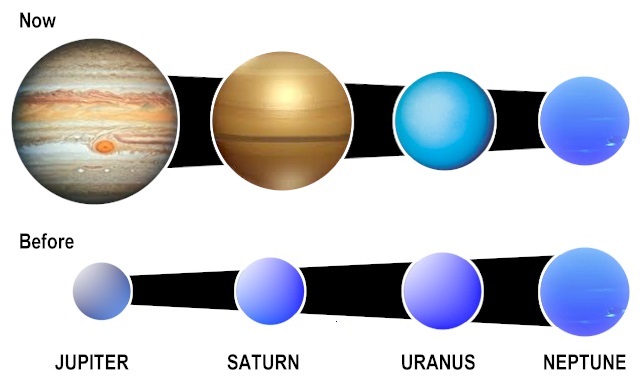
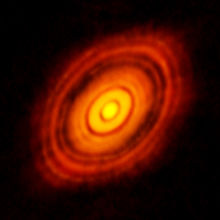
wikipedia.org
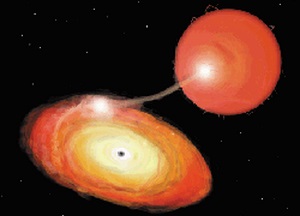
imagine.gsfc.nasa.gov
The so-called protoplanetary disks do "not" make new planets as assumed by the Nebular theory. They are just debris disks of dying stars. In addition to the dust and gas, they also contain rocks, metal, and many other different materials. They are basically the same as the asteroid belt, but much newer.
"the debris disks around these examples (e.g. Vega, Alphecca, Fomalhaut, etc.) are probably not truly 'protoplanetary', but represent a later stage of disk evolution where extrasolar analogs of the asteroid belt and Kuiper belt." (wikipedia.org)
Some observations have shown that the source of the material that makes the disk is a companion star. So if there were no companion star (second sun) in the solar system, the asteroid belt wouldn't have existed! By the end of its life, the second sun created a "protoplanetary" disk, or better say a "debris" disk; and the asteroid belt now contains remains of that disk.
Most of the dust and gas that were in the asteroid belt have collected on top of Jupiter and Saturn and increased their gas volume. Some other amounts have fallen on the inner planets, and mixed with the planets' soil, and participated in making the strong cement that glues mountain rocks together.
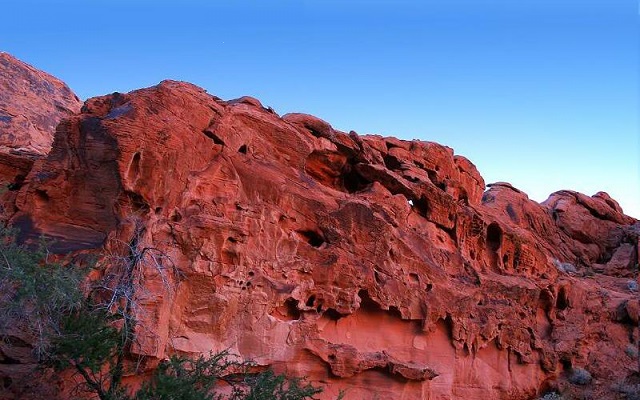
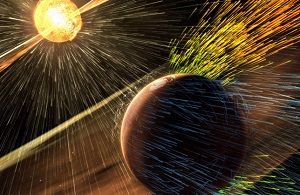
NASA studied the atmosphere of Mars and concluded
that it was stripped from the top: "The enrichment of heavier isotopes
measured in the dominant carbon-dioxide gas points to a process of loss from the
top of the atmosphere"
nasa.gov
How this happens: "a process that is thought to be driven by interactions
with the solar wind."
scientificamerican.com
Note that the so called -- solar wind -- isn't air, but a solar radiation of electrically charged particles. Solar wind of stars other than the sun is called stellar wind.
Title: "Mars Atmosphere ERODED by Sun Activity"
astronaut.com/mars...
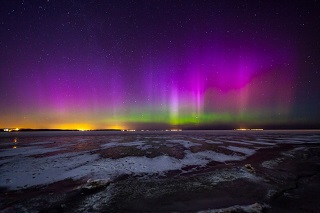
cosmosmagazine.com
Because of the atmosphere of Mars, some scientists think that the solar wind of
the existing sun was the cause: "the solar wind is thought to be very strong
at the beginning of our solar system history."
bunewsservice.com
Nobody can say that the solar wind of the existing sun has no effect at all on the atmosphere of Mars; the picture to the right shows that it penetrates the Earth's atmosphere and causes auroras near the poles, but saying that it is the one that wiped out the atmosphere of Mars cannot be correct. If this was the case, it would have affected the atmosphere of Earth much more, and for the simple reason: Earth is much closer to the sun than Mars.
Some scientists assume the magnetic field and gravity of a planet is keeping the planet's atmosphere.. The gravity of Titan is less than that of Mars, and even less than the gravity of the Earth's moon, and does not have a magnetic field, but it has an atmosphere that is denser than Earth's.
Titan interacts directly with the solar wind in the same way as Mars does: "Cassini
[spacecraft] Catches Titan Naked in the Solar Wind"
jpl.nasa.gov
Venus also does not have a global magnetic field, much closer to the sun than Mars, but its atmosphere is much denser than Earth's.
The planet's Gravity and magnetic field may play a very minor role in keeping the planet's atmosphere, but only the strong solar wind is the one that destroys it.
All of the Jupiter's 4 moons (Europa, Io, Callisto, Ganymede) have very thin atmosphere. No studies have been conducted on these planet's atmosphere, but most likely it has been stripped away from the top, just like Mars, by the solar wind of the second sun.
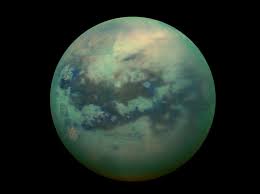
It looks like the fourth planet of the second sun, Titan, moved to Saturn very early and saved its atmosphere. But why Saturn and not Jupiter? As said before, Jupiter was smaller at that time. The second has not yet entered the phase of producing gases, it was still functioning and producing light, but with a lot of internal problems.. This leads to a conclusion that dying stars produce huge amounts of solar wind before they enter the phase of releasing gases and creating metals. Mars atmosphere was erased at this stage, the stage of solar wind, and this shows that it was very close to the second sun, far away from its current position, otherwise the solar wind of the second sun would have affected the Earth's atmosphere very severely.
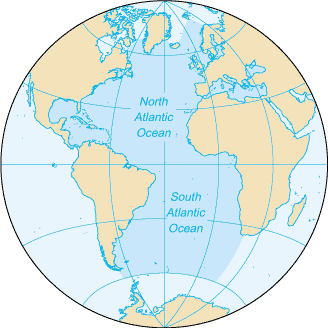
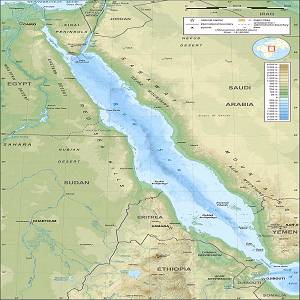
Many earth and space theories have been formulated without considering a second star in the solar system. As a result, they ended up either partially or completely incorrect. For example, two theories exist to explain the continental edges that fit together on the world map. The dominant theory is the Continental Drift, also called, Plate Tectonic. The other theory is the Expanding Earth. The plate tectonic theory states that the continents before 200 million years were united in a very vast ocean, and then they started to move. Even though this theory seems to explain the continental edges that fit together on the Atlantic ocean and other smaller seas, it completely ignores the same phenomenon on the Pacific! The Expanding Earth theory does not ignore the continental edges that fit together on the Pacific, but it does not give a reason for why the earth is expanding!
Many changes and events have taken place in Earth and other planets throughout the history of the solar system, but most of them are still a puzzle. Something must be missing somewhere!
Earthquakes, tsunamis and volcanic eruptions are still occurring, but because the specialists are unaware of what has happened in the past, in order to know how the earth works today, these disasters remain a mystery.
In this article we will try to rework some of the Earth and space theories to see how things will turn out when taking the second sun as a prime factor in the equation of the solar system.
| The Permian - Triassic Extinction Event.. This mass extinction was caused by the dying second sun, it took the Earth 30 million years to recover; the long lasting period of the extinction indicates that the cause was present all of this time |
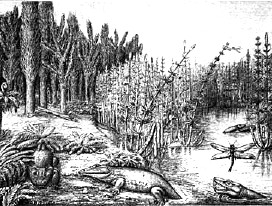
"It was almost the perfect crime. Some perpetrator -- or perpetrators --
committed murder on a scale unequaled in the history of the world. They left
few clues to their identity, and they buried all the evidence under layers
and layers of earth. The case has gone unsolved for years -- 250 million
years, that is." |
The Second Sun -- Just like many types of stars in the final period of their life, and because of the changes and events that have happened in Earth and other planets in the solar system, the second sun, most likely, have fired extremely powerful gamma rays by the end of its life. These rays have led to major changes and disasters in Earth, and also changes in the other inner planets!
According to theories, stars produce light by nuclear fusion. The nuclear fusion produces gamma rays, and then these gamma rays are converted to light. On the other hand, observations have shown that some dying stars fire strong gamma rays; this means that these stars at a very late stage of their life failed to convert the produced gamma rays to light.
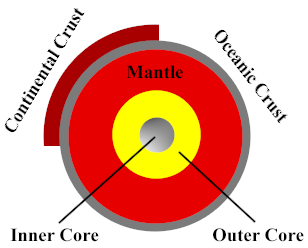
Earth Layers
The emitted gamma rays most likely have caused ionization (chemical action/reaction process) of gases inside the Earth's mantle (the layer that is just below the crust) that led the mantle to explode and the Earth's crust to break. When that happened, life extinction resulted and almost all life on Earth died out, including insects. This is the Permian –Triassic extinction event.
Large quantities of meteoroids and asteroids have fallen down from the sky and gone all the way down to the mantle via large holes and trenches that were resulted from the explosions that have taken place inside the mantle.
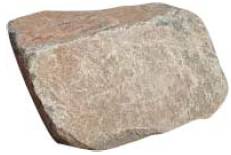
These meteoroids were actually igneous rocks, and they were originally part of the dying second sun, manufactured by the second sun in the phase of making metals and chemicals. They were thrown by the second sun and then they came to orbit the planets. After they fell on Earth, they formed the ocean floor and rocky mountains, as well as the lowlands and mountains in the other inner planets.
Few Rocks: "there are few
250 million-year-old rocks left on Earth. Most have been recycled by our
planet's tectonic activity"
science.nasa.gov
The absence of rocks is attributed to a "theory" that hasn't been proven to exist before 200 million years! If the carbon dating of the "few" rocks is correct, they are very likely meteorites landed on Earth from outer space.
We have seen earlier that the gas planets were filled with gases according to their distance from the second sun, based on the 2nd law of thermodynamics, but the case with the rocky planets is different, the amount of rocks they got was proportional to their original size; bigger planets attract more rocks than smaller planets; this can be seen now, bigger planets have more moons and rocks orbiting them than smaller planets, the same thing happened in the past.
Most, if not all, of the base metals on Earth such as iron, magnesium, platinum, gold and silver have come from the second sun. They arrived on Earth either as pure metals or as ingredients of rocks, which are the same rocks that contain metals now, specifically the rocks that make up the ocean floor and mountains, plus the molten rocks inside the mantle.

Because of the added material, the earth has expanded, and its mass has increased. The expansion happened only once, and the earth is "not" continuously expanding as stated by the Expanding Earth theory. And because of the water that is filling the ocean basins, the land chunks (continents) started to drift! There was no continental drift before the expansion of Earth.
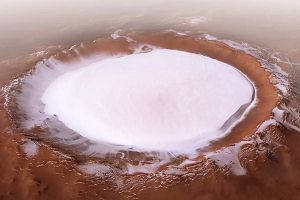
The ocean waters came from the dying second sun; arrived on Earth as as ice
asteroids, like the one that is found on Mars now, in the picture to the right.
This may sound strange, do stars produce water? Water is oxygen and hydrogen,
chemical elements manufactured inside dying stars: "Astronomers have detected
a massive cloud of water vapor around an aging
star."
science.nasa.gov
Before the formation of the ocean floor, only shallow water existed on Earth in lakes and rivers. Regarding mountains, only sandstone mountains existed in the past. The only mineral that can be found in the old sandstone mountains is coal. Even though coal is not metal, but people have to mine it, that is why it is classified as mineral.
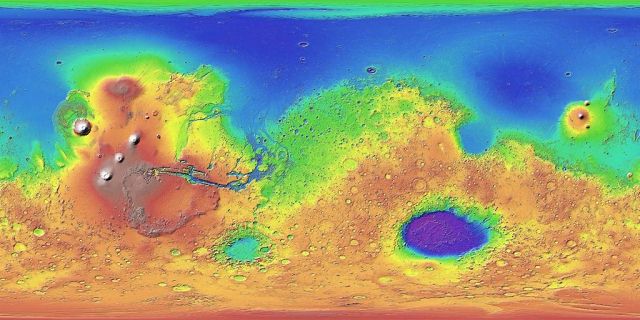
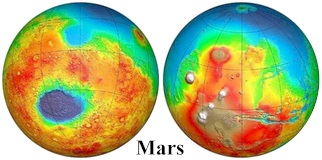
The other inner planets have also expanded. The lowlands (blue) on the other planets, which are equivalent to the ocean floor on Earth, are added parts, plus mountains. According to the crater counting technique, the surface of a planet that has more craters must be older than the surface, on the same planet, with less craters.. All lowlands, in all planets, have very few craters compared to the highlands! This is a clear and visible indication that they have been created at a very late time. The lowland on Earth is the sea floor; no sea floor on Earth is older than 200 million years. After knowing this about the lowlands on other planets, the assumption of Earth recycling the sea floor and mountains every 200 million years becomes invalid and without any basis. The earth generally is no different from the other terrestrial planets in the solar system.. The only difference between Earth and the other planets is water; and must be the factor, or at least the main factor, that causes continents to drift on Earth; before the expansion of Earth and the added water, there was no continental drift.
The following quote is from an article about the Permian-Triassic extinction event.
"The Earth was engulfed in widespread volcanism at the
time of the extinction."
science.nasa.gov
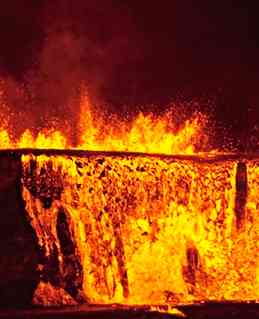
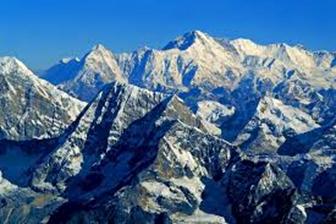
As said earlier, the fired gamma rays by the second sun caused ionization of gases inside the Earth's mantle that led to huge increase in gas pressure that resulted in explosions.
Rocks started to fall from space (originally were parts of the second sun) and go all the way down inside the open trenches. Some of these rocks were melted inside the Earth's mantle and reproduced to make the sea floor. Other rocks were stacking up inside other trenches and building mountains. At the same time the Earth was expanding. The evidence that supports that this was actually the case is that no seafloor is older than 200 million years and no rocky mountain is older than 200 million years, all over the Earth. In addition, there is no physical evidence to show any tectonic activity before 200 million years.
What made the falling rocks to fall inside the open areas is that moving ionized gases create a magnetic field, and the falling rocks contain iron and magnetism. So the rocks were attracted to these areas more than anywhere else.
Some mountains have remained underground for a long time, and then raised by a rising magma from the mantle. Some other mountains are still being raised until this day.
The sea floor is changing size, enlarging in some places and shrinking in other places, depending on the way the Earth balances the water on its surface.
What we have here is NOT a natural process that is governed by a predetermined natural law, but an accident that caused a sudden change; so the results are unpredictable. Now, for example, the Atlantic is expanding and the Pacific is shrinking; but will this process continue forever like that? It is up to the Earth to decide. The same thing is true for mountains; it has been noticed that the Himalaya Mountain is still rising! But for how long will this rise continue? It will certainly stop in one day, just like the other mountains that have already stopped; and another mountain may start to rise, or may not.
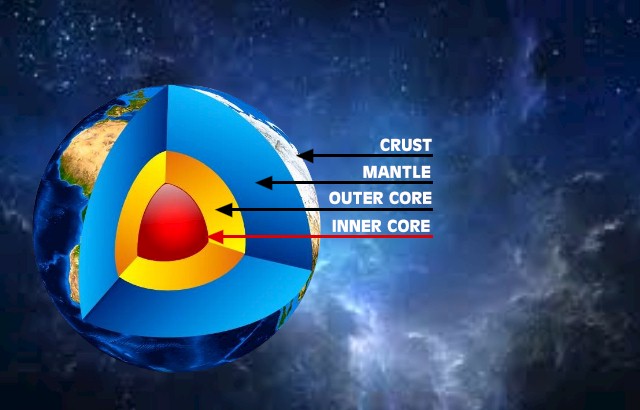
The earth inner core, that is made of iron and nickel, isn't as old as the earth itself, as some might think, but it is an added part at a very late time, and it is getting bigger. Some scientists give it an age of about 500 million years only, compared to the Earth estimated age 4 billion years.
"The inner core is a relatively recent addition to our planet and establishing when it was formed is a topic of vigorous scientific debate with estimates ranging from 0.5 billion to 2 billion years ago." (sciencedaily.com)
What applies to the inner core of Earth must also apply to the other solar system planets, and we have to initially assume that all of them got their inner core at a very late time.
It looks like the fallen rocks that stayed inside the mantle got melted and released their metallic elements, including iron. The extracted iron started to sink to the earth center and concentrate there to form the inner core. So the formation of the earth core is an ongoing process until this day and it is getting bigger because the rocks are still releasing metal and the metal is sinking to the earth center. Since there was no iron or any other metal on Earth before 200 million years, it is impossible for the earth core to be older than 200 million years.
The young age of the Earth metal core adds evidence that shows that Earth had no metal at all before 200 million years, not even inside the earth internal layers.

Left: Banded Iron Formation (BIF). Right: Star debris disk (the source of BIF)
Banded Iron Formations (BIFs) are layers of iron on old sedimentary rock (sandstone), supposedly formed in sea water of the ancient seas and bacteria releasing oxygen. The assumption here is that BIFs were formed when the Earth received huge amounts of waters mixed with rust from the second sun debris disk. The supposed ancient seas are nothing but the waters from the second sun.
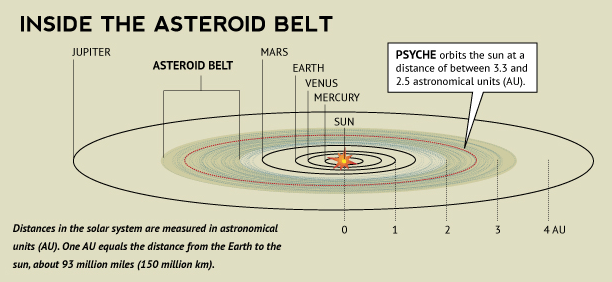
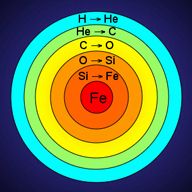
The picture above shows the orbit of a metal (iron) asteroid in the main asteroid belt, called, Psyche. It is almost in the middle of the belt. It has a diameter of about 250 km. It has not been visited or investigated yet. It could be the inner core of the second sun or a major part of it. Note that there is NO inner core in stars that are functioning normally, but some stars by the end of their life, when they start making metals, they develop what can be called a star inner core.
Some think that this metal asteroid is an exposed inner core of a planet failed to form, on the assumption that the inner core of a planet is made first. The late addition of the earth's inner core proves this assumption incorrect.
Table of Contents
2. Earth with 2 Sunrises and 2 Sunsets (The Night Sun)
4. A Nuclear Explosion on Mars!
5. The Source of Rocks on the Surface of Mars?
6. Life Extinction 250 Million Years Ago!
7. The Source of Waters in the World Oceans
8. The Source of Metals on the Earth
9. The Size and Nature of the Second Sun
10. Expansion in All Inner Planets
11. Earth has Expanded and Continents are Drifting!
12. The Effect of Water on the Earth's Lowland
1. The Solar System Formation
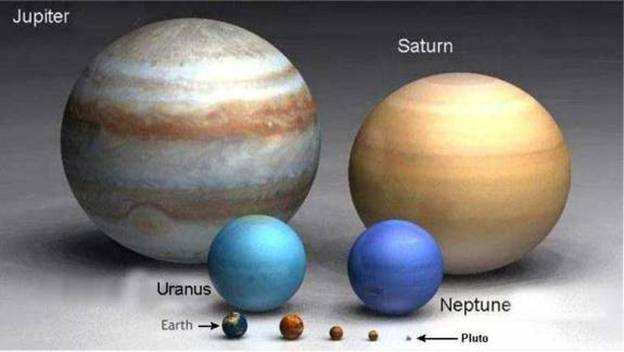
The solar system consists of the so-called inner planets, which are the ones that are inside the circle of the asteroid belt; and the outer gas planets, which are behind the asteroid belt.
The apparent reason for the gas planets (Jupiter, Saturn, Neptune and Uranus) to remain in a gas from is that they are far away from the sun.
All space organizations around the world are adopting the Solar Nebular theory as the base for star and planet formation.
The nebular hypothesis has been formulated in the 18th century, in times when people knew nothing about binary (double) star systems; thinking that all solar systems in space are like our solar system in the present time; one sun and few planets revolve around it; and assuming our solar system in the past was exactly the same as it is today.
The idea of dust and gas did not come from no where, but from the materials that make up the earth. The earth consists of dust and gas, so it is assumed to have been made from dust and gas!
Even though the Nebular theory seems to work, at the first glance, with the the rocky planets, it fails to explain the gas giants: "The formation of giant planets is another unsolved problem." (wikipedia.org)
Space technology kept improving, and astronomers kept adjusting and improving the nebular theory accordingly. In the 1990s they found some new stars (some and not all) do have dust and gas belts around them. As a result: they associated the finding with their theory.
A written summary of the solar system formation is in the following paragraph:
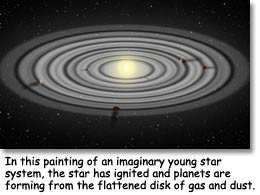
"Almost five billion years ago, our solar system had its
beginnings as a vast cloud of dust and gas. The cloud began to collapse,
flattening into a giant disk that rotated faster and faster, just as an ice
skater spins faster as she brings her arms in. The Sun formed at the center,
and the swirling gas and dust in the rest of the spinning disk clumped together
to produce the planets, moons, asteroids, and comets. The reason so many objects
orbit the Sun in nearly the same plane (called the ecliptic) and in the same
direction is that they all formed from this same disk."
spaceplace.nasa.gov
The problem is that not all young stars have dust belts around them.
In addition, the observed disks are not made of pure dust and gas, but they
also contain rocks, metals and other materials, so that they can be interpreted
as debris disks: "the debris
disks around these examples (e.g. Vega, Alphecca, Fomalhaut, etc.) are probably
not truly 'protoplanetary', but represent a later stage of disk evolution
where extrasolar analogs of the
asteroid belt and Kuiper belt."
wikipedia.org
Without a companion star, the asteroid belt wouldn't have existed!
It is said that the protoplanetary disk (also called accretion disk and nebular disk) is increasing in size, whereas the debris disk is not. This point could be true because the dying star which is releasing the dust and gas is still active but hidden under the dust. The extra volume of dust and gas must come from somewhere anyway; and if it is not coming from a hidden dying star under the dust, then where is it coming from?

imagine.gsfc.nasa.gov
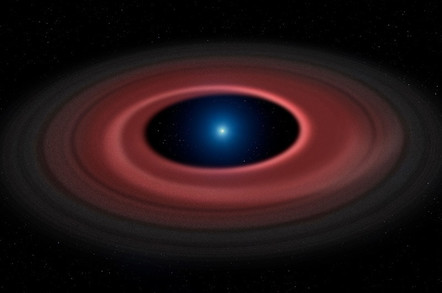
sciencephoto.com
Based on the previous example, this dust and gas must have come out from the dying star itself. It had no other place to go to and stayed around its mother star. Now this star is dying, so how is it possible for planets to form around a dying star?
Regardless of the function of black holes and whether the black hole is pulling the disk material from the companion star, or the companion star is just releasing the material without any pulling force, the material itself is the same as the material that makes up identical disks around other types of stars, young or aging stars.
If observations have shown that the disk material comes from a dying companion star, then the natural explanation for the asteroid belt is to say that it contains material from a dead star that once existed in the solar system.
These observations also show that the idea of accretion disks creating new planets and stars is completely wrong. It seems that a recycling process of the material inside a black hole is needed before the material can be used again for making new planets and stars.
The dark energy in the outer space is pushing everything away form everything else, so how is it possible for gases or dust or whatever thing to come together to form planets and stars without an extraordinary force to overcome this mysterious energy. The only known force so far that is capable of collecting stars debris is black holes. So it looks like the giant black holes will collapse in one day, and new planets and stars, in a gas form, will be born.
It has been observed, elsewhere in the universe, that there are some gas planets orbit their stars in very close distances. These gas planets are in the size of Jupiter and Neptune.
Theorists think that these gas planets have come from very far places to orbit their stars very closely. So they formulated a theory called planet migration. This theory is based on the locations of the gas planets in the solar system, on the assumption that the gas planets in the solar system have been in their current positions since the beginning of time, otherwise nobody has seen the so-called hot-Jupiters and hot-Neptunes migrating from outside to inside.
It seems that these hot-Neptunes and hot-Jupiters are newly born planets, in a gas form, and they are now being developed into terrestrial planets very near their stars, by the stars' energy.
Back again to the debris disk, and since there was no black hole in the solar system to suck the disk material, it is better search and see where the disk material has actually gone.

By looking at the gas planets in our solar system, we can see that the closer the gas planet to the asteroid belt, the bigger it is. The reason is that the dust and gas clouds did not perform the supposed function. Instead of making new planets, they have just gone and accumulated over (or mixed with) existing planets, Jupiter and Saturn, and increased their gas volume!
Uranus is very far away from the Asteroid belt, so it got small amounts of light gases that increased its size very slightly. Neptune is the farthest planet from the Asteroid belt, and most likely got nothing.
This leads to a conclusion that all of the gas planets when they initially formed at the beginning of time they were in the size of Neptune, and with the exact same chemical composition, but the huge amounts of gases, dust and rust produced by the dying second sun changed their sizes and chemical properties.. The inner planets most likely were also in the size of Neptune, but the solar energies from the two stars turned them into terrestrial planets.. The closer the planet to the sun the smaller it is, whether it is a terrestrial or gas planet; we have already talked about this point in the Overview section.
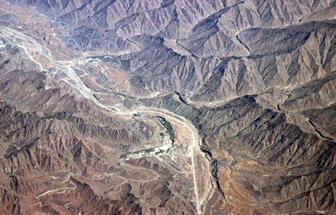

The inner planets (including the earth) must have also received some of the dust and gas from the dying sun. They have been used to seal and cement mountain rocks.
Higher concentration of rust on Earth is found in the so-called Triassic sandstone mountains and in the red desert sands.
But it seems that most of the gases were attracted to the gas planets. It
could be because they are in a colder place; according to the second law of
thermodynamics: heat flows spontaneously from a hot to a cold body. The second
sun by the end of its life failed to convert gases to light, so the hot gases
from the dying second sun have gone to the cold bodies, Jupiter and Saturn.
The Initial Orbit of the Moon
 |
 |
| The Moon | Mercury |
And if it were a planet, where was it initially?
The moon's surface features, atmosphere and size are very similar to that of Mercury. These signs indicate that the two objects have lived in a very similar environment. And since Mercury is near the sun until this day, the moon must have been also there for a very long period of time.
"Like the moon, Mercury has very little
atmosphere... Mercury is the smallest planet in our solar system -- only
slightly larger than the Earth's moon... Mercury has a solid, cratered
surface, much like Earth's moon"
solarsystem.nasa.gov
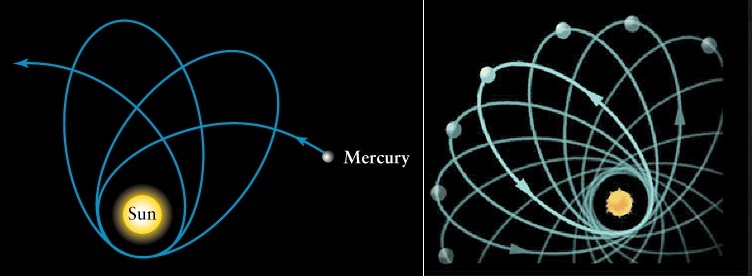
The orbit of Mercury (see the image above) could have been caused by a missing planet between Mercury and the Sun. If we assume now that there was a planet between Mercury and the Sun, that planet, in one way or another, would have prevented Mercury from having this strange orbit.
In the 19th century, a French astronomer suggested a very small planet between Mercury and the Sun, and called his planet, Vulcan. The suggested theory states that when Vulcan passes between Mercury and the Sun, it causes Mercury to deviate from its orbit slightly. But no such planet has been discovered so far. (wikipedia.org)
Some say the problem of Mercury's orbit is solved by Einstein's theory of general relativity. If Einstein's theory indeed solved the problem, beyond any doubt, then why the search for the supposed planet Vulcan is ongoing: "Searches of NASA's two [twin] STEREO spacecraft data have failed to detect any vulcanoids between Mercury and the Sun" (wikipedia.org)
The similarity of Mercury and the moon, and the strange orbit of Mercury, indicate that the moon was initially the first planet next to the sun.
The moon might have received a heavy impact at a very late time that pushed it out of its original orbit around the sun, and then it started to move away.
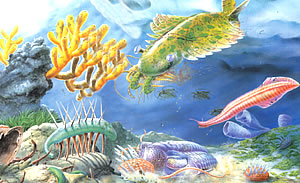
The shift of position of the moon is very likely has taken place in the Cambrian period, and the moon might have been the reason that triggered water to come out from the Earth's mantle to the surface of Earth, that led to the sudden appearance of life on Earth in the Cambrian Explosion.
There are theories about the origin or formation of the moon, details
on the links below or a web search on the topic of the moon formation:
csep10.phys.utk.edu
space.com
The closest theory to what we have in this page is the Capture
theory; it states that the Earth caught a passing body which has originally
formed somewhere else in the solar system. The Capture theory however is not the
dominant theory. In fact, according to the first link above, it has been ruled
out! But we have looked at it from a different point of view; and based on this
view, we found it the most suitable theory.
Binary Systems
Binary (double) star systems do exist in the universe, but not many of them have been found with planets. Not because they do not contain planets, but because the Nebular theory has no place for planets in binary star systems, so astronomers do not search for planets in these system.

sciencedaily.com
In the quote above, it seems that they were surprised to see an earth-like planet in a binary star system where the two stars are not far apart, and the planet is orbiting one star and not both. This situation is considered impossible using the currently accepted model of planet formation.
Another example of binary star systems is planet Kepler-16b.
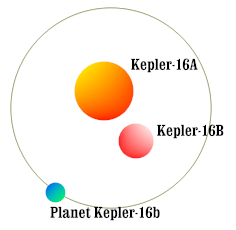 QUOTE:
"Kepler 16b is 200 light years from Earth. Kepler 16 is a binary star system
comprising of Kepler 16A and Kepler 16B, note that Kepler 16B is the star and
Kepler 16b is the planet. Kepler 16A is an orange dwarf with 69% the mass of the
sun, while Kepler 16B is a red dwarf with 20% the mass of the sun. The two stars
are separated by a distance of 20.5 million miles (33 million km). The combined
energy produced by the two stars is much less than that produced by our own sun.
Kepler 16b is a gas giant very similar in mass and radius to the planet Saturn."
QUOTE:
"Kepler 16b is 200 light years from Earth. Kepler 16 is a binary star system
comprising of Kepler 16A and Kepler 16B, note that Kepler 16B is the star and
Kepler 16b is the planet. Kepler 16A is an orange dwarf with 69% the mass of the
sun, while Kepler 16B is a red dwarf with 20% the mass of the sun. The two stars
are separated by a distance of 20.5 million miles (33 million km). The combined
energy produced by the two stars is much less than that produced by our own sun.
Kepler 16b is a gas giant very similar in mass and radius to the planet Saturn."solarsystemquick.com
Even though this system is very different from our solar system, it does show that a planet orbiting two stars, and far away from the stars' energies, remains in a gas form. But if it were orbiting "between" the two stars, and close to their various forms of energies, it is most likely to have been a rocky planet.
Both stars are dying stars, the bigger star (16A) is an orange dwarf, and the smaller star (16B) is a red dwarf. The planet itself is in the size of Saturn. It is very likely the planet initially was much smaller than its current size, but the gases released by the dying two stars, have been collected on top of, or mixed with, the planet and increased its size and mass.
There is no mention at all of any kind of belts in this binary system (Kepler
AB). And it is unlikely to form at any time in the future, because not all stars
are the same, and not all stars end up in explosions. But if we assume the
explosion of one of the two stars, then the exploded star will form an asteroid
belt around the other star, and the planet will orbit one star plus the asteroid
belt, just like Saturn now.
Kuiper Belt
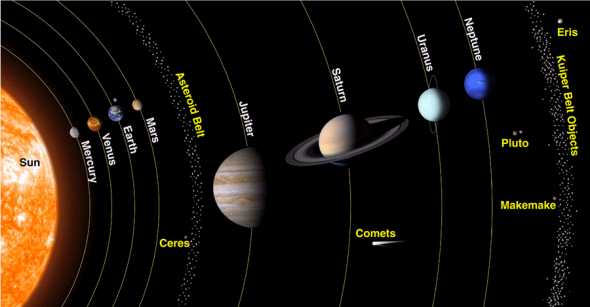
The asteroid belt isn't the only belt in the solar system, there is also another belt surrounding the entire solar system; it is called Kuiper belt. The dwarf planet Pluto is considered an object of Kuiper belt.

Not much is know about Kuiper belt, but if the objects of it are the same as the ones in the asteroid belt, then it must have been a star.
Based on observations that we have talked about earlier, which are summarized in the picture to the right, it looks like the solar system was originally a black hole, and Kuiper belt star was orbiting it. The star died and the black hole recycled the material that the star produced. The black hole finally exploded and gave birth to the solar system planets and two suns.
2. Earth with 2 Sunrises and 2 Sunsets (The Night Sun)

Now we will see how the situation on Earth was when the second sun was functioning normally.
Oxygen isotope data from ancient sedimentary rocks suggest that the early
Earth was much hotter than today: "according to oxygen isotope records, early
Earth surface temperatures could have been as high as 45 – 85 degrees C!"
atoc.colorado.edu
On the other hand, it is said that the early Sun was cool, giving only about 70% of solar heat, or even less. So where did the extra heat on the earth come from? Many theories have been suggested, but without any supporting evidence at all. (space.com)
In the present time a day on the Earth is 24 hours, but the early Earth's day
is said to be much shorter. It was about five to six hours only. One theory
suggests that a large object, in the size of Mars, impacted the Earth and set it
to spin very fast. But there is no sign of such a large object to ever hit the
earth: "Scientists estimate that a day in the life of early Earth was only
about 6 hours long."
spaceplace.nasa.gov
Now we have alternative explanations, the early earth was not rotating so rapidly, it is just the other sun made the day seems very short; one sun sets and the other sun rises. Regarding the early Earth's surface temperature, the extra heat was coming from the second sun.
3. Why is Mars Red?
 QUOTE:
"The short answer to 'why is Mars red' is that the planet is covered
in rust.
Iron oxide to be exact... The short answer does not explain where all of the
iron oxide comes from, though. There is a larger percentage of iron on the
Martian surface than there is on other planets. The exact source is unknown,
but many scientists believe that it came from the volcanoes that used to erupt
all over the planet."
QUOTE:
"The short answer to 'why is Mars red' is that the planet is covered
in rust.
Iron oxide to be exact... The short answer does not explain where all of the
iron oxide comes from, though. There is a larger percentage of iron on the
Martian surface than there is on other planets. The exact source is unknown,
but many scientists believe that it came from the volcanoes that used to erupt
all over the planet."universetoday.com
According to the answer above, volcanoes could have been the source of rust. But volcanoes did not produce the same result on other planets, not even close! Needless to say that there is no evidence to show that volcanoes existed all over Mars, let alone they were behind this rust. The total number of volcanoes on Mars that once were active is about 20 only. Now all of them are dead.
On the other hand, Venus had more volcanoes than Mars:
"Venus has more volcanoes than any other planet in the
solar system. Over 1600 major volcanoes or volcanic features are known (see
map), and there are many, many more smaller volcanoes. (No one has yet counted
them all, but the total number may be over
100,000 or even over
1,000,000)... None is known to be active at present, but our data is
very limited. Thus, while most of these volcanoes are probably long dead, a few
may still be active."
volcano.oregonstate.edu
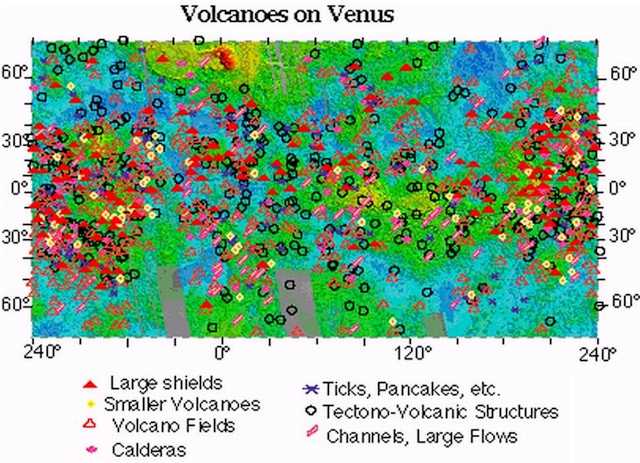
Even though Venus had much more volcanoes than Mars, the planet does not have any noticeable rust, or we better say it cannot be seen from long distances like Mars.
Venus, as well as all of the other inner planets, must have some amount of iron oxide on their surfaces, came from the dying second sun.
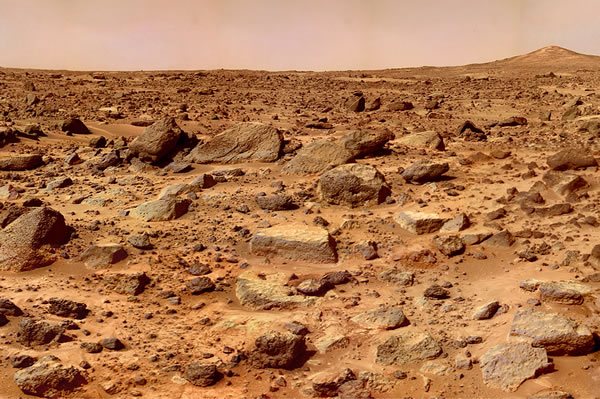
By looking at the surface of Mars, we see a layer of very fine rust covering the whole planet. It is like someone held a blower and blew fine rust, in equal quantities, on the surface of Mars. And that is exactly what happened, but the blower was very, very big!

These "rusty" sandstone mountains are called Triassic sandstone because they date back to the Triassic period; at the end of the Permian-Triassic extinction event, 200 million years ago.
This rust could have been occupying a portion of the the debris disk, or the
disk itself kept changing color from time to time depending on the released
material from the dying second sun. And then it has fallen on Earth and mixed
with the Earth's soil.
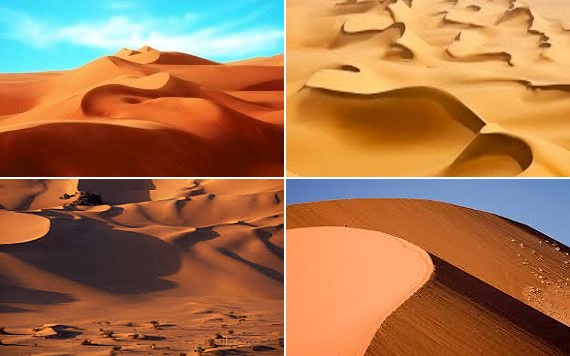
Desert sands on Earth
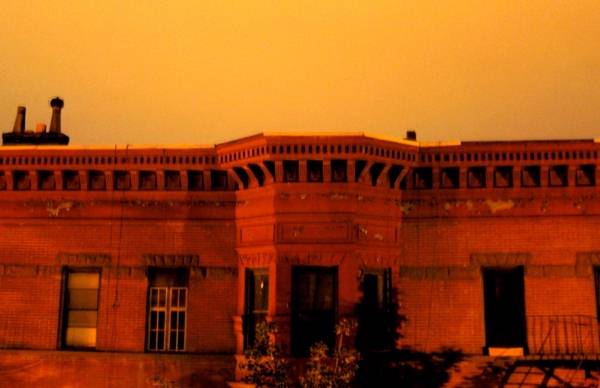
scientificamerican.com
If we take now the radiometric dating of the Triassic sandstone as a
reference, we can tell that these desert sands have got the iron oxide at the
same time as the mountains, because the sandstone was originally sand: "Triassic
sandstone was formed in a sandy desert environment. It is made up of
quartz crystals held together in an iron oxide rich cement; this cement gives
the rock its characteristic red colour."
/people.bath.ac.uk
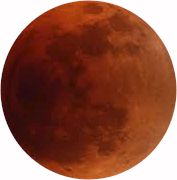
The Earth's moon also has iron oxide in some areas: "The mare [lowland]
regions have low reflectance because they contain relatively high amounts of
iron oxide (FeO). Some mare basalts contain unusually high amounts of
titanium oxide (TiO2) in addition to iron oxide, making for even lower
reflectance. TiO2 also shifts the color of the mare
from red to blue."
nasa.gov
As you can see in the quote above, the lowlands on the moon should be red, but the addition of titanium oxide turned them to blue. Titanium oxide (TiO2) is also a product of dying stars. Because the moon is a very dry object, no wind is there, these chemical elements remained where they have been "deposited" initially. It is very likely the highlands also got some amounts of iron oxide, but much less. The moon's lowlands are on the facing side only; the dark side has almost no lowlands.
The question now is: if iron oxide is (iron + oxygen), and there is no oxygen on the moon, what caused the iron to rust?
According to the quote above, some of the moon's lowlands contain unusually higher amounts of titanium oxide than other lowlands. Unlike Earth, the moon does not have any atmospheric or environmental changes, so what makes one basalt area different from another basalt area? This is an indication that these chemical elements have been deposited on the moon at a later time.
The crater counting technique gives the lowlands of the moon an age of 200
million years only: "Lunar maria (lowlands) have only 1/20 the crater density
of the lunar highlands, therefore, they should be 1/20 the age, right? So, by
this reasoning, if the highlands were 4.5 billion years old, as old as the
Earth, then the maria would be just 200 million years old."
coursehero.com
astro.umd.edu
This age estimate of 200 million years is very reasonable, because it matches the age of the sea floor and rocky mountains on earth, plus the rusty Triassic sandstone mountains. So if the moon's lowlands have an age of 200 million years, then the iron oxide and titanium oxide must have been deposited on these areas after they were created.
It doesn't seem there is any data about iron oxide on the "surface" of Venus published on the web in the time being, or it hasn't been known yet.
According to the link below, Mercury has about 3% of iron oxide on its surface: "Direct observations from Earth indicate that it is 3 percent iron oxide by mass, compared to Earth's 8 percent." (holoscience.com)
The same logical question arises again: if Mercury does not have any oxygen at all, what caused the iron to rust on Mercury?
QUOTE: "Mars has twice as much iron oxide in its outer layer as Earth does." (wikipedia.org)
So if the percentage of iron oxide on Earth is 8 percent, Mars, according to the Wikipedia link above, should be 16 percent.
If we try now to arrange the inner planets based on the percentage of iron oxide they got on their "surfaces," we should have them in the following order: Mars, Earth, Venus, Mercury.

Percentage of rust on the surfaces of the inner planets
The closer the inner planet is to the asteroid belt, the higher percentage of iron oxide it has on its surface. Anything below the surface is just a supposition.
4. A Nuclear Explosion on Mars!
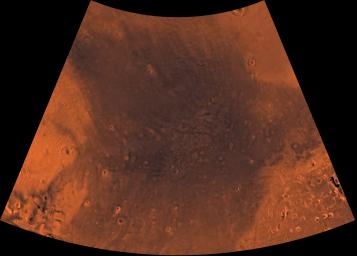
Mystery: "It has long been a mystery of why there is a super-abundance of
uranium, thorium, and potassium on the Martian surface concentrated near Mare
Acidalium in the region of the large, shallow depression. Also, the Martian
atmosphere has an unusual amount of radiogenic isotopes. An explanation for this
Martian mystery was presented by Space Physicist John Brandenburg at the 42nd
Lunar and Planetary Science Conference in Houston, TX this month. According to
the press release, Brandenburg suggests, evidence shows that approximately 180
million years ago the planet Mars was devastated by a massive natural nuclear
explosion. This natural event filled its atmosphere with radio-isotopes,
irradiated its soil and atmosphere with neutrons, and spread a layer of
radioactive material on the surface of Mars. His analysis estimates the force
of the explosion to have been in excess of 1 million one megaton hydrogen bombs."
tucsoncitizen.com
The quote above is based on the assumption that a nuclear reactor has developed naturally on Mars, and then exploded by itself. The explosion was in excess of one million hydrogen bombs; each bomb is one million ton.
This kind of explosion nobody can say for certain it can happen naturally in a planet, but stars are nuclear reactors basically. And if the explosion indeed has taken place on Mars itself, it would have created huge craters on its surface, but no such craters exist!
It looks like the explosion has taken place in the neighborhood, and the concentration of its radiations and radioactive materials was Mars.
However, the pollution of radioactive materials on the entire surface and atmosphere of Mars may not be due to the explosion only, but also due to the radiation of the dying star on the planet Mars over a very long period of time; just like the rust.
5. The Source of Rocks on the Surface of Mars

"The average surface abundance of centimeter- to meter-scale rocks is much greater on Mars than the other terrestrial planets." (wikipedia.org)

QUOTE: "the Martian crust consists mostly of volcanic basalt rock." (space.com)
Just like the rust, the assumed source of these rocks is volcanoes; but volcanic rocks on Earth look completely different from the rocks on the surface of Mars!
Basalt (also called Mafic) rock is rich of iron and magnesium. And these metallic elements are ingredients of the rock. In order to make such a mix, a very special process is required, and not the normal natural factors like wind and rain. This indicates that they have arrived readymade from factory. And that factory must have been capable of manufacturing iron and magnesium, a star.
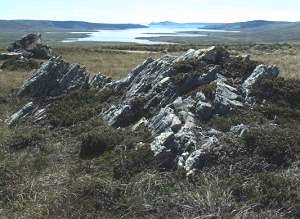
wikipedia.org
At the time when the rocks were falling from the sky, the surface of Earth was most certainly very similar to the surface of Mars, rocks everywhere, but because of the geological changes, most of them have been buried and converted to metamorphic rocks. The evidence to show that this was actually the case is the so-called called rocky outcrop: "An outcrop or rocky outcrop is a visible exposure of bedrock or ancient superficial deposits on the surface of the Earth... Outcrops do not cover the majority of the Earth's land surface because in most places the bedrock or superficial deposits are covered by a mantle of soil and vegetation and cannot be seen or examined closely. However, in places where the overlying cover is removed through erosion or tectonic uplift, the rock may be exposed" (wikipedia.org)
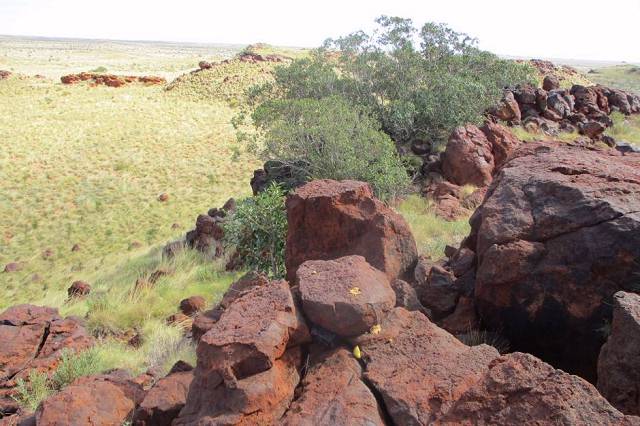
abc.net.au
The Rocky outcrops in the picture above were originally basalt, like the rocks that make up rocky mountains, but due to weathering they lost their properties. The way they were deposited is very much similar to those of Mars.

6. Life Extinction 250 Million Years Ago!
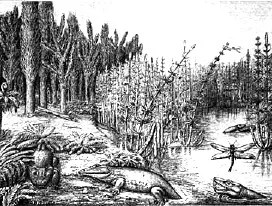
"Among paleontologists, it's sometimes called the 'Great
Dying.' Roughly a quarter of a billion years ago, 90-95 percent of all life on
Earth died out. It took 30 million years for the planet to recover. What
happened? Most people are familiar with the extinction event 65 million years
ago that wiped out the dinosaurs. But the Great Dying was much more devastating.
It left almost nothing alive... Earth scientists Sarda Sahney and Michael J
Benton call it 'the most devastating ecological event of all time."
io9.com/5558871/...
Wikipedia: Permian –Triassic extinction event
wikipedia.org...
The Great Dying
mtu.edu/research/...
It is mentioned in the quote above that 90-95% of life on the earth died out. It took the earth about 30 million years to recover. This type of life extinction adds evidence that shows that a completely abnormal event has taken place on Earth around that time, and lasted for a very, very long time. The cause must have been present all of this time.
Following this event is the formation of sea floor, rise of rocky mountains, and continental drift. Theorists, however, do not see any relationship between these events; even though they happened at exactly the same time, and on the same planet!

science.nasa.gov
"Scientists have suggested many possible causes for the
Great Dying: severe volcanism, a nearby supernova, environmental changes wrought
by the formation of a super-continent, the devastating impact of a large
asteroid -- or some combination of these. Proving which theory is correct
has been difficult."
science.nasa.gov
It is written in the quote above that the cause could be a combination of these. Now if a "combination" is considered, this combination cannot be separate and isolated cases, all of them happening simultaneously in the same time, but a kind of one event triggering another, or one factor causing all of these events to happen together. Later in this section we will see a sign pointing to space as the source of this "combination."
Another assumed cause: "Lava flow 250 million years ago likely killed most of Earth's life --A massive flow of molten rock, bubbling to the surface and spreading more than a mile deep over an area half the size of Australia, may have killed up to 90 percent of all animal species on Earth some 250 million years ago, a study suggests. The study shows that the flood of molten rock that created what is known as the Siberian Traps in Russia was almost twice as big as previously believed and could have continued for thousands of years, changing the climate of the entire planet." (seattlepi.com)
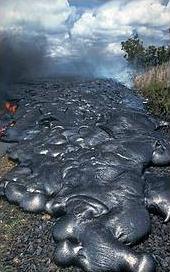
NASA has sent a team to sites in Hungary, Japan and China to study supposed causes of the Great Dying. There are rocks, originally fallen from space, in these countries with sizes of 6 to 12 km across, as big or bigger than Mt. Everest. The rocks still exist and have been exposed.
A sign pointing to space as a cause of the extinction:
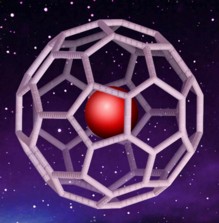
"Deep inside Permian-Triassic rocks, Becker's team found
soccer ball-shaped molecules called 'fullerenes' (or 'buckyballs') with traces
of helium and argon gas trapped inside. The fullerenes held an unusual number of
3He and 36Ar
atoms -- isotopes that are more common in space than on Earth."
science.nasa.gov
From the same article at the link above; some have suggested that the fallen
rocks caused the extinction, but others believe that life has been already wiped
out when the rocks have arrived. The team leader said: "If life suddenly has
all these different things happen to it," Becker says, "and then you slam it
with a rock the size of Mt. Everest -- boy! That's just really bad luck."
science.nasa.gov

Mt. Everest
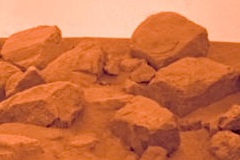
Rocks on Mars
What can be seen in the quotes above is "not" only the isotopes that are more common in space than on Earth, but also the rocks that contain these isotopes have actually fallen down from space. These rocks are exactly identical to the rocks that make up rocky mountains. And after knowing this, you don't need a magic formula to figure out that the rocks that make up rocky mountains have actually come from space, at the time of the extinction.
Identical rocks (at least in shape) are those that are found on the surface of Mars. And if the distribution of these rocks on the surface of Mars is more than any other planet, then the space object that distributed the rocks must have been near Mars. Now we are not trying to assume the impossible, but only using the common sense to see what has actually happened, and when it happened.
7. The Source of Waters in the World Oceans
"More massive stars begin a further series of
nuclear burning or reaction stages. The elements formed in these stages range
from
oxygen through to iron."
sciencelearn.org.nz
universetoday.com
"Astronomers have detected a massive
cloud of water vapor around an aging star."
science.nasa.gov
Water = oxygen + hydrogen, chemical elements manufactured inside dying stars.. Oxygen is the third-most abundant element in the universe, because the universe contains a lot of stars.
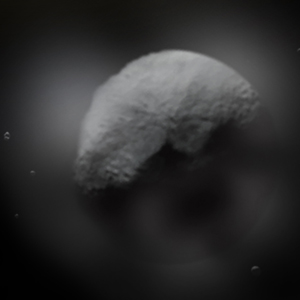
Water in the asteroid belt: "Dwarf planet Ceres in asteroid belt may contain more freshwater than Earth" (rawstory.com)
Ceres is an icy object; with a diameter of about 950 km; orbiting in the outer edge of asteroid belt; far away from the sun heat. It is very likely a rock with water ice building on it.
Every single object orbits in the asteroid belt in the present time gives an
idea about an attribute of the original object that used to exist there in the
past, and Ceres is no exception. It is a leftover sign indicating that the
object that used to be there was a generator of oxygen and water.


Water on Mars: "The only place where water ice is
visible at the surface is at the north polar ice cap.
Abundant water ice is also present beneath the permanent carbon dioxide ice cap
at the Martian
south pole and in the shallow subsurface at more temperate
conditions. More than 21 million km3 of
ice have been detected at or near the surface of Mars, enough to
cover the whole planet to a depth of 35 meters (115 ft).
Even more ice is likely to be locked away in the deep subsurface."
wikipedia.org
The quote above says that the water ice on Mars is found in two places, at
the north pole and at the south pole. The amount of ice in these two places only
is enough to cover the whole planet to a depth of 35 meters.. The northern polar
cap has a diameter of 1000 km, and the southern polar cap has a diameter of 400
km, so the total is 1400 km only. The whole planet shows traces of flowing
water, which means that this amount of water ice, that is found in two places
only, was in every part of the planet, on the assumption that this amount hasn't
changed, which is unlikely the case. What was the source of it? The planet
itself? No, the picture of the ice crater above says it all. All of it came to
the planet from an external source, a very close source, otherwise the water ice
would have stayed in a colder place, for example, around Neptune; heat flows
from a hot to a cold body, not the other way around.
Life on Earth: Before the addition of the ocean waters, Earth had some form of primitive life, started in the Cambrian period.
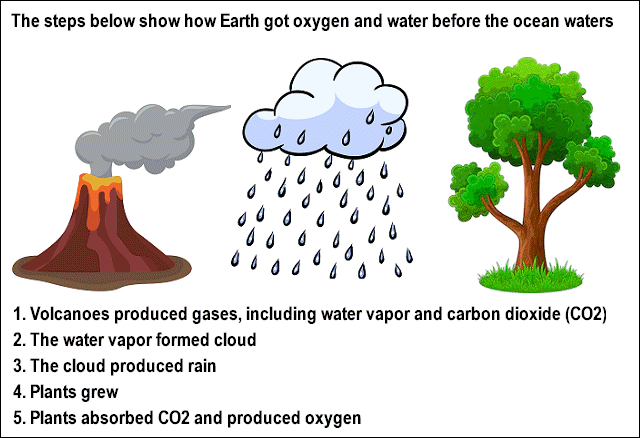
The steps mentioned in the picture above are also happening now; so there is no reason to assume a different way for the same things that are happening today in a certain way.
"Superheated water vapor is the most common gas
released during volcanic eruptions... Carbon dioxide is the second most
abundant gas released from volcanic eruptions."
sciencing.com
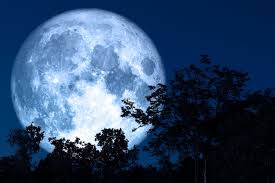 We have seen in the section about the formation of the
solar system
that the moon's initial position was the first planet next the Sun, and then
shifted.
We have seen in the section about the formation of the
solar system
that the moon's initial position was the first planet next the Sun, and then
shifted.
It is very possible that the moon has come to orbit Earth at this time (in the Cambrian period) and caused the dynamic effects that forced the water to come close to the surface of Earth, in the upper part of the Earth's mantle.
When the water vapor came close to the upper part of the Earth's mantle, it started to come out from volcanic eruptions and forms clouds and then rain.
A sudden appearance of life means a sudden change of a normal process, otherwise life would have started gradually. So a major factor must have been inserted suddenly in the equation of Earth that produced a different result.
The moon may also be a major factor in volcanic eruptions.. Many studies have been conducted to see whether or not the moon is causing volcanoes on Earth, but they didn't find any direct relation.. It could be an indirect factor; the moon is one factor, when it is combined with one or more other factors, a volcanic eruption takes place.
The Moon of Jupiter Io: Studies have shown that the gravity of Jupiter and the moon Europa are causing volcanic eruptions on the moon Io: "Its hundreds of volcanoes are caused by heat coming from the gravitational push and pull between Jupiter and the nearby moon Europa." (space.com)
The case of the moon Io shows that volcanoes are caused by external factors; the Earth is no different. If they couldn't find a relation on Earth, it doesn't mean the relation doesn't exist. It simply means they couldn't find it.
But how Earth got that small amount of water that started life with it before the ocean waters?
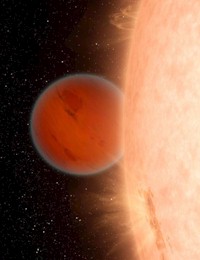
In the section about the solar system formation we assumed that all planets were initially in a gas form, in the size of Neptune, based on observations of gas planets orbiting their stars very closely.
The solar system planets that were orbiting the sun very closely have been converted into terrestrial planets by the sun, and the other planets remained in a gas form.
The farthest planet from the sun is Neptune, and it is the least affected by gases from the second sun; so if we take it as an example of an undeveloped planet, that will help us understand the mixture that makes up planets.
"Neptune is very similar to Uranus. It's made of
a thick soup of water, ammonia, and methane over an Earth-sized solid
center. Its atmosphere is made of hydrogen, helium, and methane. The methane
gives Neptune the same blue color as Uranus."
solarsystem.nasa.gov
No one has gone inside Neptune to see what is there. Everything that is said
about the internals of planets other than Earth is theoretical, but if the
theory about Neptune is correct, or partially correct, this applies to all
planets, and based on this we can conclude that Earth had some amount of water
since the time when it was born in a gas form.
8. The Source of Metals on the Earth
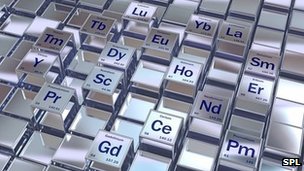
All of the base metals on Earth such as iron, gold, silver, platinum, zinc, copper, etc. are not originally made on Earth, because Earth is a planet, and planets do not have enough energy to create these elements from atoms. The base metals can be made only in very powerful nuclear reactors, in stars.
sciencedaily.com
imagine.gsfc.nasa.gov
What we see in the two quotes above is that metallic elements have been delivered to Earth, as well as to the other inner planets in our solar system, from a star that is not the same as our sun.
Metallic elements like iron can be either pure metals or metals as ingredients of rocks. These rocks are the same rocks that make up ocean floor and mountains. And since there is no rocky mountain on Earth older than 200 million years, and there is no ocean floor older than 200 million years, we have to say that the metals along with their containing rocks, have arrived to Earth around that time only, about 200 million years ago.
science.nasa.gov
The link above is about the Permian-Triassic extinction event; the quote says that there are only "few" rocks older than 250 million years left on Earth.
The "few" rocks that are older than 250 million years in the quote above are very likely meteorites landed on Earth from outer space, just like the meteorites that land on Earth nowadays from time to time. And these meteorites can be rocks, metals, or rocks containing metals.
The absence of rocks is attributed to a "theory" that hasn't been proven to exist before 200 million years! The surprise is that the so-called tectonic activity that has recycled ALL of the rocky mountains on Earth, has left huge sandstone mountains untouched!
These sandstone mountains do not contain metals at all; this a fact nobody can reject it; no need to know anything about radiometric dating in order to know that these mountains are completely different from the sandstone mountains that were created after the mass extinction 200 MYA; simply search for metals; do you find any? no; that is it, the Earth has undergone a dramatic change. Sandstone mountains are made from the earth soil, if there is no metal in the soil, the mountains will not contain metals; as simple as that.
If the supposed ancient oceans have ever existed, they must have left some traces behind, one piece of a seafloor at least, but nothing is there, they are imaginary oceans; what applies to the ancient rocky mountains, applies also to the ancient oceans, they have never existed before 200 million years, so anything is attributed to them cannot be correct, including Banded Iron Formation (BIF).
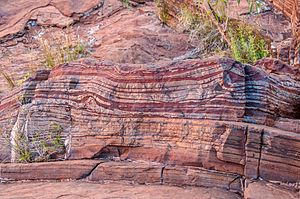
BIFs are layers of iron on old sedimentary rock (sandstone), supposedly formed in sea water of the ancient seas and bacteria releasing oxygen.
The planet Mars does not have oceans or tectonic activity to recycle the seafloor, or bacteria to release oxygen, but the same material is found there:
"Hematite... is a common iron oxide with the formula Fe2O3... Huge deposits of hematite are found in banded iron formations... The spectral signature of hematite was seen on the planet Mars by the infrared spectrometer on the NASA Mars Global Surveyor and 2001 Mars Odyssey spacecraft in orbit around Mars. The mineral was seen in abundance at two sites on the planet" (wikipedia.org)
BIFs formed under "sea" water and are NOT forming today:
BIFs are not forming today because the factor that made these layers does not exist anymore, this is the only reasonable explanation. The 200 meters mentioned in the quote above is 200 meters above sea level in the current standards.
"Study confirms banded iron formations originated from
oxidized iron"
sciencedaily.com
Oxidized iron is iron oxide, rust.

Left: Banded Iron Formation (BIF). Right: Star debris disk (the source of BIF)
The way these layers were made is difficult to imagine, maybe one layer at a time, sand is accumulating over the first layer, water mixed with rust falling from the debris disk of the second sun on the previous layer, one layer on top of another, and the process continues. The time the whole process has taken to complete maybe millions of years.
The old ages given to BIFs are based on analysis of the mineral zircon, it is found now everywhere in the crust of Earth.
The most likely reason for the mineral zircon to be found in BIFs is contamination.. The added water flowed on the surface of Earth, carried with it elements (including zircon) from the surface of Earth, the elements got mixed with the water, to finally settle on the old sandstone mountains, building Banded Iron Formations.. This assumption has been proven correct in some places: "Influence of contamination on banded iron formations in the Isua supracrustal belt" (sciencedirect.com)

As long as there is no piece of a mountain, or a seafloor, to prove the existence of metal on Earth, anything else is subject to contamination, or meteorites falling from space, more than 90 percent of meteorites are of rock, while the remainder consist wholly or partly of iron and nickel.

We have already talked about the earth inner core in the Overview section, and we saw in that section that the earth did not have any metal at all before 200 million years, not even inside the earth's internal layers.
It is said that the Earth's tectonic activity recycles the sea floor and rocky mountains every 200 million years, but does it also recycle the Earth inner core?!
9. The Size and Nature of the Second Sun
| Supernova Explosion | |
 |
|
| After Explosion | Before Explosion |
| imagine.gsfc.nasa.gov | |
The current star theories divide stars into two categories: white dwarf stars and neutron stars. 90% of stars in space are categorized as white dwarfs. The remaining 10% are neutron stars that explode as supernova. The supernova explosion is so huge to the point that you can see it very clearly even with the naked eye. Based on these two categories, we conclude that no solid material whatsoever can be found in dead stars. A nuclear explosion in the size of supernova will not even leave a grain of dust to remain intact. And white dwarfs are only condensed gases that fade away over time. However, on the link below dead stars were found polluted with rocks and metals.
"NASA's Hubble Space Telescope Finds Dead Stars
'Polluted with Planet Debris"
nasa.gov
There are two theories to explain the supposed "planet debris", the link above talks about the leading theory; it states that nearby planets push rocky bodies toward the stars, and then these rocky bodies start orbiting the dying stars.
The other, recently suggested, theory says that the planet debris is the leftover from planets that the stars have destroyed:
"Theory suggests source of white dwarf
pollution… A decades-old space mystery is how the metals came to be in white
dwarf atmospheres. And now an international team of astronomers led by Professor
Martin Barstow of the University of Leicester in the U.K. say they have solved
the mystery. Their solution points to an ominous fate for planet Earth.
Professor Barstow said in a press release: The mystery of the
composition of these stars is a problem we have been trying to solve for more
than 20 years. It is exciting to realize that they are swallowing up the
leftovers from planetary systems, perhaps like our own."
earthsky.org
It is a matter of interpretations; dying stars found polluted with rocks and metals; that is all. No one has seen nearby planets pushing materials toward the stars, or has seen the stars destroying nearby planets.
The natural explanation is to say that the supposed planet debris have actually come out of the original stars after they have broken apart. It is like seeing a collapsed building; you don't need anyone to tell you that the junk you are seeing is the materials that were making up the building. But if you limit your conclusion to two options, then you have to pick one of these two options only, even if the selected option doesn't make sense at all. Saying so however doesn't mean no stars end up their life as condensed gases that vanish slowly over time, but to limit all stars in space to two categories only is a problem.
It seems that the second sun is very similar to, if not the same as, these dead stars that are found polluted with the so-called planetary debris; and of course, the source of the debris is the dead stars themselves, manufactured by the stars in the phase of manufacturing metal and other chemical elements.
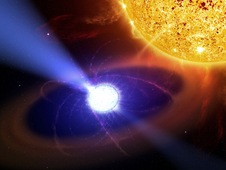
The Sun of the solar system is classified as a star that will end up as a white dwarf. Based on this theoretical classification, it is supposed to vanish without doing anything at all. Now this assumption is challenged. A star that has been classified as a white dwarf was found acting like a pulsing star:
"New observations from Suzaku, a joint Japanese Aerospace Exploration Agency (JAXA) and NASA X-ray observatory, have challenged scientists’ conventional understanding of white dwarfs. Observers had believed white dwarfs were inert stellar corpses that slowly cool and fade away, but the new data tell a completely different story. At least one white dwarf, known as AE Aquarii, emits pulses of high-energy (hard) X-rays as it whirls around on its axis. 'We’re seeing behavior like the pulsar in the Crab Nebula, but we’re seeing it in a white dwarf,' says Koji Mukai of NASA Goddard Space Flight Center in Greenbelt, Md. The Crab Nebula is the shattered remnant of a massive star that ended its life in a supernova explosion. This is the first time such pulsar-like behavior has ever been observed in a white dwarf." (nasa.gov)
Based on the quote above, we assume that the second sun acted as a pulsar by the end of its life, producing gamma rays, not just x-rays.
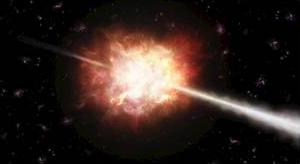

science.nasa.gov
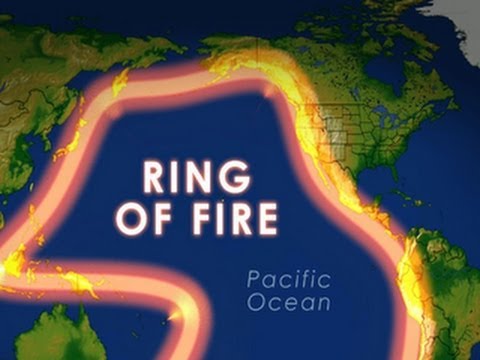
Gamma ray is very penetrating. Even machine-made gamma ray can penetrate, for a certain degree, through lead.
When gamma rays pass through matter, they eject electrons from the atoms they strike. This process is called ionization. It is an action-reaction chemical process that can create new substances and compounds, which can lead to an increase in volume and/or pressure.
The ionization process that have taken place inside the mantle, when the earth was struck with gamma rays, caused a great increase in gas pressure, inside the mantle, that led the mantle to explode and the crust to break, in order to release the extra gas pressure.
The explosions that have taken place inside the mantle created very big holes and trenches in the crust.. Based on debris from the earth's mantle found on the surface of earth, which is exactly the same as volcanic debris, scientists think the Earth was engulfed in widespread volcanism during the mass extinction 200 MYA.
Via the open areas and trenches in the Earth's crust, asteroids and meteoroids from the second sun have gone into the earth's mantle, caused the earth to expand, and mountains to rise.. The rocks that have fallen inside the mantle got melted and created the ocean floor, whereas the rocks that have stacked up created mountains.. Because the ring of fire area contains the oldest ocean floor, it is most likely the first area to explode and open.
10. Expansion in All Inner Planets
All inner planets have lowlands and highlands. All lowlands on all of the planets are made of molten basalt rocks, and they are younger than the highlands.. The oceanic crust is the lowland of Earth.
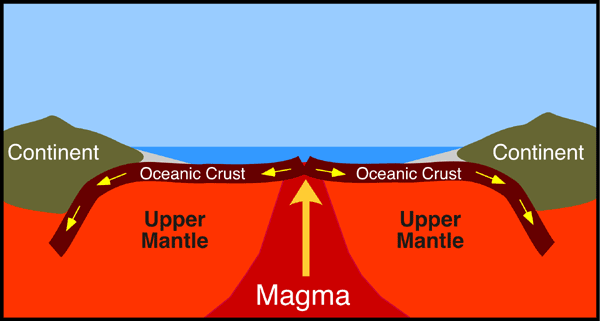
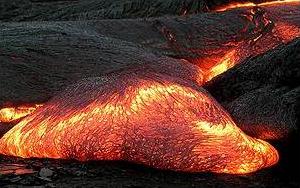
At the time when the rocks were falling from the sky, they fell either in trenches to build mountains, or go directly to the Earth's mantle, to be reproduced to make the ocean floor. The reason for the rocks to target these places is their high magnetic field. The magnetic field was created by moving ionized gases; the ionization of gases was created by gamma rays from the dying second sun.
QUOTE: "Motion of an ionized gas will produce a magnetic field."
stars.astro.illinois.edu
Since the falling rocks contain iron and magnetism, they were attracted to the nearest magnetic field.
However, the falling rocks are not breaking, they fall in slow motion, because the gravity of Earth at that time was much weaker than it is now.
Cracked Surface, Faults -- a countless number of cracks have taken place all over this new solid layer. These cracks are the same as the ones that are called 'Faults' by the tectonic theory. The exact number of cracks is unknown, and the way they were created is random.
Any solid and closed container is subject to cracks due to temperature changes. Temperatures inside the mantle are much higher than temperatures above the crust. The result is cracks everywhere. Some are short cracks, and some others are long. Cracks are a must for the mantle to breath.
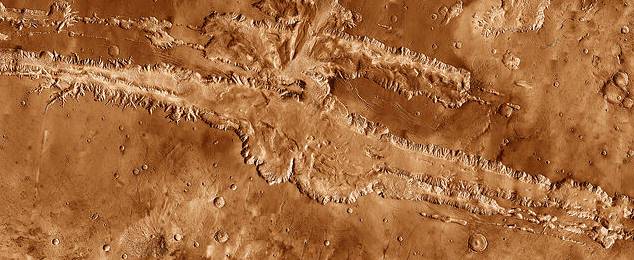
A long crack on the surface of Mars, over 4,000 km
"It has been recently suggested that Valles Marineris is a large tectonic 'crack' in the Martian crust." (wikipedia.org)
They think that Mars had tectonic activities! It never had any similar to Earth. Only little movements when the planet expanded and the new solid layer was built, plus cracks for the mantle to breath.
Mercury, the moon, Venus and Mars, plus the planets of the second sun, all of them must have cracks on their surfaces, because all of them have expanded. Cracks on Mercury, the moon, and Mars have been discovered, but not on the other planets.
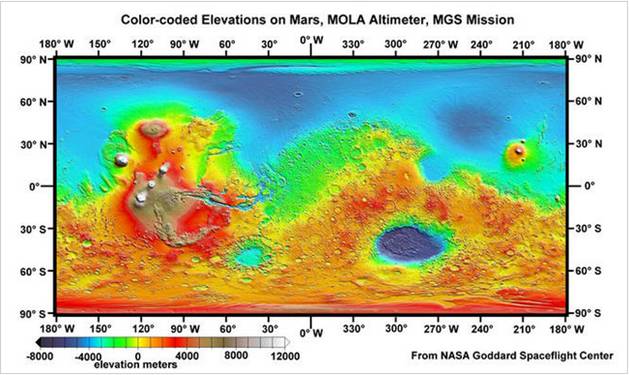
The above map of Mars shows some of the planet's lowlands and highlands. You can see on the scale below the map that the lowlands are lower up to 8km (-8000 meters on the scale). Like the seafloor on Earth, the lowlands on Mars are made mainly of molten basalt rocks.
It can also be seen on the map above that the number of impact craters on the lowlands is much less than the highlands. This is a clear indication that the lowlands are much younger than the highlands.

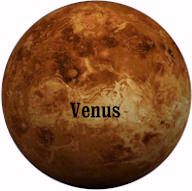
Some ancient cultures called the dark areas on the moon "seas," assuming there is water on the moon. This assumption is proven incorrect, and there are no seas on the moon. However, these dark areas are still called lunar maria. In Latin, maria is the plural of mare, and means seas.
These dark areas on the moon are not at the same level as the so-called highlands. And just like the seafloor on Earth, and the lowlands on Mars, the moon's lowlands are also made of molten basalt rock!
Venus is very close to the sun, the temperature there is very high, about 460°C, and its atmosphere is very thick, so that the surface of the planet cannot be seen. However, radar images show that Venus has lowlands and highlands. About 80% of Venus is lowland.
"It is hypothesized that Venus underwent some sort of global resurfacing about 300–500 million years ago, though no Venusian rock has ever been dated. One possible explanation for this event is that it is part of a cyclic process on Venus. On Earth, plate tectonics allows heat to escape from the mantle. However, Venus has no evidence of plate tectonics, so this theory states that the interior of the planet heats up (due to the decay of radioactive elements) until material in the mantle is hot enough to force its way to the surface." (wikipedia.org)
Because the lowlands on Venus are much younger than the highlands, they have been dated between 300 and 500 million years. But this is just an assumption. Those who have given this date, they could easily date them 200 – 300 million years, as old as the sea floor on Earth.
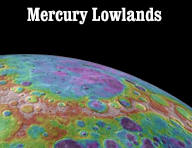
Mercury is the closest planet to the sun. Its size is about the size of the
moon. And just like the other inner planets, it does have lowlands and
highlands. Visually the lowlands on Mercury appear much younger in age than the
highlands.
The only difference between the Earth's lowlands and the lowlands on the other
inner planets is that the lowlands on Earth are filled with water, oceans,
whereas the others are still empty.
The age of the seafloor on Earth is estimated to be about 200 million years old, compared to the earth's highland which is about 4.6 billion years old. The given explanation is that the seafloor is being recycled every 200 million years.
The explanation for the lowlands on the moon, as well as Mercury, is that impacts of heavy meteorites have pushed the crust down, and then lava flowed on these lowered surfaces. But the source of the supposed lava flow on these surfaces hasn't been found yet! No traces of any large volcanoes are found anywhere on the moon that can produce such large areas of lowlands.
Unlike the moon and Mercury, Venus does not have large impact craters on its surface, nor has oceans and tectonic activities to "recycle" the seafloor every 200 million years, but it does have lowlands and highlands!
The estimated age of the lowlands on the moon is about 3.5 "billion" years, whereas the highlands, like the earth, is about 4.6 billion years. However, this age estimate seems very much exaggerated.
It seems that those who have done the radiometric test on some of the moon's rocks have ruled out rocks with small numbers of years, in one way or another, and tried to push the date back as much as possible, so that the numbers appear reasonable to them.
 Another
technique of estimating the age of a surface is by counting the impact craters
on the surface; the greater the crater density, the older the terrain. The
crater counting technique gives the lowlands of the moon a very different age:
Another
technique of estimating the age of a surface is by counting the impact craters
on the surface; the greater the crater density, the older the terrain. The
crater counting technique gives the lowlands of the moon a very different age:
"Lunar maria (lowlands) have only 1/20 the crater
density of the lunar highlands, therefore, they should be 1/20 the age, right?
So, by this reasoning, if the highlands were 4.5 billion years old, as old as
the Earth, then the maria would be just 200 million years old."
coursehero.com
As you can see in the quote above, the crater counting technique gives the lowlands of the moon an age of about 200 million years only, as old as the ocean floor on earth!
Visually the moon's lowlands look much younger than the highlands. So something must have gone wrong with the radiometric dating technique to give very old ages for areas that look very, very new.
11. Earth has Expanded and Continents are Drifting!
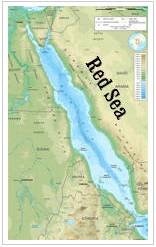
The fact is that there are parts of the continental crust, have been shaped in such a way, so that if they are pushed side by side they would fit together.
On the other hand, there are theories. But theories are not facts. They can be right or wrong. Any theory is just a thought trying to explain a fact, when the real cause of the fact is unknown.
The dominant theory for explaining the earth shaping is the Plate Tectonics, also called the Continental Drift. Another less famous theory is the Expanding Earth. (wikipedia.org)
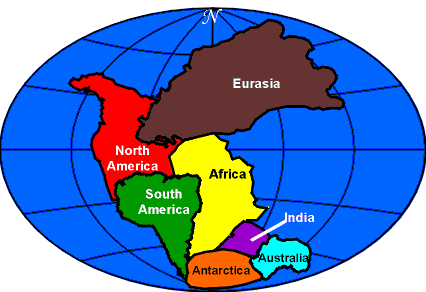

World map; Atlantic centered
The tectonic theory states that the continents before 200 million years were in one single land sitting in a very vast ocean (right). And then these land chunks started to move, without any reason, and without any defined dynamic process! And because no reason is given for their movements, they are called, sometimes, wandering plates.
A major problem with the tectonic theory is that it views the world map from the Atlantic Ocean only, neglecting the Pacific, because the theory does not have an explanation for the matching edges on the pacific.
There are parts on the map, if they are viewed from the other side, from the pacific, they will fit perfectly too!
The expanding (continuously expanding) earth theory is more reasonable, because it deals with the map from all angles.
However, neither the Expanding Earth theory has an answer for why the earth is expanding, nor the Tectonic theory has an answer for why the so-called plates sat stationary for a very long time and then started to move all of a sudden. Moreover, both theories are not taking into consideration the ages of the lowlands of the other inner planets!
Regarding the Expanding Earth theory, the earth is not continuously expanding, it has just expanded once.
The fact is that neither the ocean floor existed nor the continents have ever moved before 200 million years.
If we take everything related to the earth structure into account, not ignoring anything, we have to say the Earth has expanded, and the continents are drifting. In other words, the Expanding Earth theory and the Continental Drift theory are both correct in certain aspects.
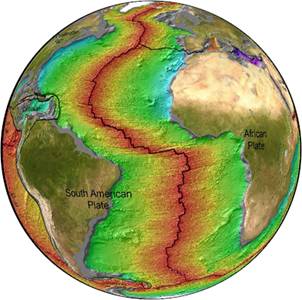
Atlantic-centered world map

Antarctica; ridges from all sides, no trenches
By looking at the mid-ocean ridge of the Atlantic, it can be seen clearly that the continents on both sides of the Atlantic are being pushed away from each other. The red color represents the newest seafloor. The yellow areas are older than the red, and so on. The green seafloor is about 150 million years old. (sos.noaa.gov)
Antarctica is another example of the continental drift. It is surrounded by ridges from all sides. No trenches are found inside the circle of ridges of Antarctica.
The continents did not sit stationary for a long period of time, and all of a sudden started to move without any reason. The expansion of Earth, and the water that filled the ocean basins, as we will see in the next section, are the reasons behind the drift of the land chunks.
Next we will see that there are parts of the world do fit together from the Pacific Ocean.
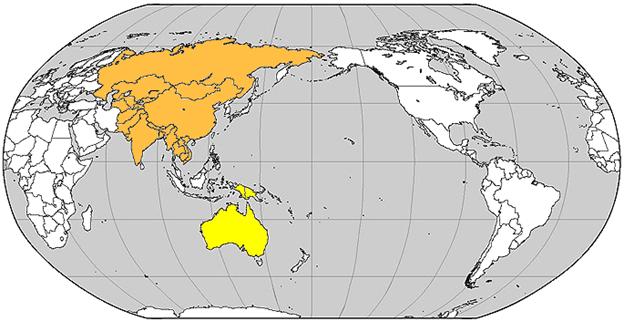
Pacific-centered world map
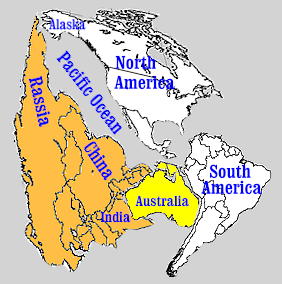
From the world map above, which is the Pacific Ocean centered, the shape in the picture to the right was produced.
A very simple turning of the colored areas, and without any artwork, we have something on the other side of the map that fits perfectly.
It is true that the parts that fit together from the other side are more, but not all of them do fit. The Mediterranean Sea doesn't fit, the Black Sea doesn't fit, the Gulf of Mexico doesn't fit, and many other areas do not fit.
The point is that we are NOT dealing with something that works according to a systematic natural law, but with an accident! Therefore, we should not expect, for example, a car accident to dismantle the car very nicely! Some parts may remain intact, but not all.
The Atlantic resulted from a crack in the basaltic layer at a late time, whereas the Pacific resulted from the initial explosion in the earth's crust, when the internal gas pressure exceeded the maximum limit. This fundamental difference in the way the two areas were separated produced different results.
At one period of time, the Pacific Ocean was small, just as it is shown in the picture above. Later on, the brown area was pushed away. And at a very late time, Australia separated.
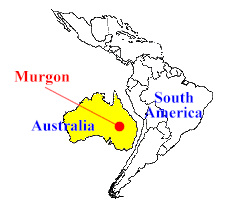
Fossil discoveries prove that Australia and South America were connected together at least 50 million years ago.
"The first evidence we have of marsupials [kangaroo-like
animals] in Australia comes from the 55 million-year-old fossil site at
Murgon in southern Queensland. This Murgon site has yielded a range of
marsupial fossils, many with strong South American connections. At Murgon
there is also evidence of a placental mammal, known as a condylarth. Placental
mammals were also found in North America and
South America at this time."
australia.gov.au
This fossil record is a shortcut for knowing that Australia was attached to South America at some period of the earth's history. From the other side of the pacific, the map shows China and India were connected to Australia. The pacific was initially small. All of this leads to a conclusion that Earth expanded.
Not only the earth expanded, but also all of the inner planets, and also the planets of the second sun:
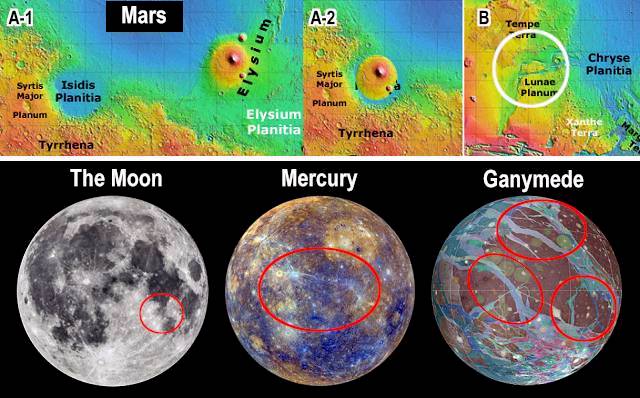
The upper part of the picture above is of Mars; figure A-1 shows a rounded lowland; A-2 shows that the piece of land where the volcano is fits in the rounded lowland. Figure B shows a white circle and a piece of land inside; this piece of land fits the land edges from two sides with a little distortion.
The bottom part of the picture shows the moon, Mercury and Ganymede (a planet of the second sun); the red circles show the matching edges.
Basically all rocky planets in the solar system have expanded, whether they are planets of the existing sun or the second sun, they all have matching edges, and if it is possible to carbon date the lowlands of these planets accurately, their ages will be found about 200 million years old only, as old as the ocean floor on earth. Unlike Earth, the other planets are inactive geologically; they expanded once, and then they remained stationary. The water is the main factor that makes the land chunks on Earth drift continuously.
12. The Effect of Water on the Earth's Lowland

Mars seems very much similar to Earth 200 million years ago, the lowlands are on one side and the highlands are on the other side.
The first lowland to form on Earth was in the Pacific ocean.
Land chunks on Earth have changed position, but on Mars and the other rocky planets they remained in the same place where they were created initially. The main difference between Earth and the other planets is water.
Based on what is seen on Mars and the other inner planets, it is very likely the earth's lowland was flat in the beginning, without ridges and trenches. But just like winds and rain change the surface features of the continental crust, the sea water also changes the surface features of the oceanic crust.
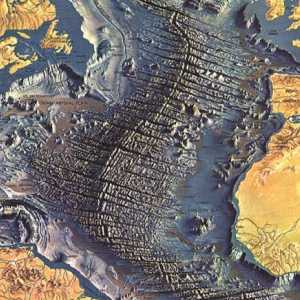
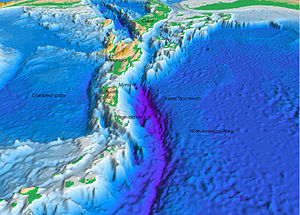
Gases released from the earth's interior created clouds in the sky, which have produced rain that put weight on ocean floor.
This shift of energy, from the interior of the earth to the surface of the earth, must have caused a problem for the Earth stability.
The earth adjusted itself with the new situation by introducing ocean ridges and trenches. Expanding at the ridges and shrinking at the trenches.
The cracked solid, basaltic, layer of the Earth allowed ridges and trenches to form.
At ocean ridges, magma rises from inside the mantle and builds new ocean floor. At ocean trenches, parts of the ocean floor fall down inside the mantle. This process causes parts of the land to spread away at ocean ridges, and other parts to come closer to each other at ocean trenches.
When ocean basins were filled with a considerable amount of water, the Earth tried to balance this water on its surface. It is like putting a weight on one side of a ball, and you see the air is being pushed to other sides. The water in the world oceans is the main factor that causes the land chunks to drift; without the water, Earth will be just like Mars, the lowlands are on one side, and highlands are on the other side.
Most of the water received by Mars evaporated to space very quickly due to the thin atmosphere of the planet, otherwise it would have continental drift like Earth.
13. How Are Mountains Formed?

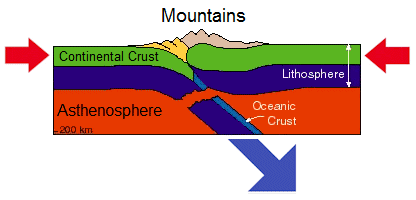
One of the greatest mysteries that are found on Earth is mountains. Many theories to explain mountain formation have been put forward over the last 100 years or so, but it doesn't seem that these theories are convincing; so new theories for mountain formation are still showing up from time to time.
Mountain formation, according to the tectonic theory is represented sometimes by two arrows opposite to each other and a single mountain block in between, to mean that the arrows or plates pushed the mountain block up. And based on this idea, it is thought that mountains are collections of rocks put together on top of the continental crust, and they are completely isolated from the earth's mantle that is made of basalt rock.
The Earth isn't the only planet that has mountains; all the rocky planets have mountains too.
There is no water on the moon; and it does not have a continental crust as the earth does, but it has mountains that are exactly the same as mountains on earth (see the picture below). There on the moon, the mountains are "connected" directly to the basalt layer that is equivalent to the sea floor on Earth. And this shows that mountains are not pushed by the continental crust, because there is no continental crust on the moon. In other words, mountain rocks were dropped from the sky, in trenches, and then pushed up by a rising magma from the mantle.
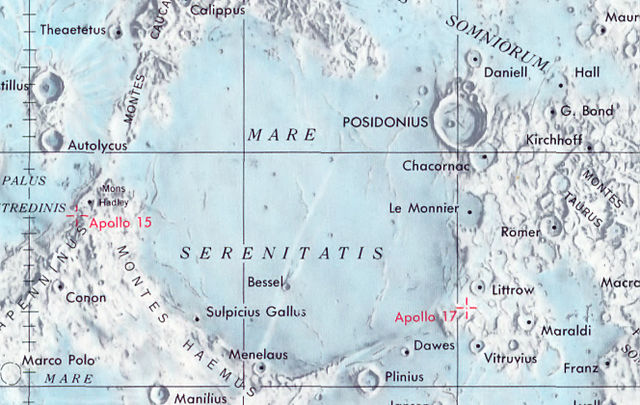
hq.nasa.gov
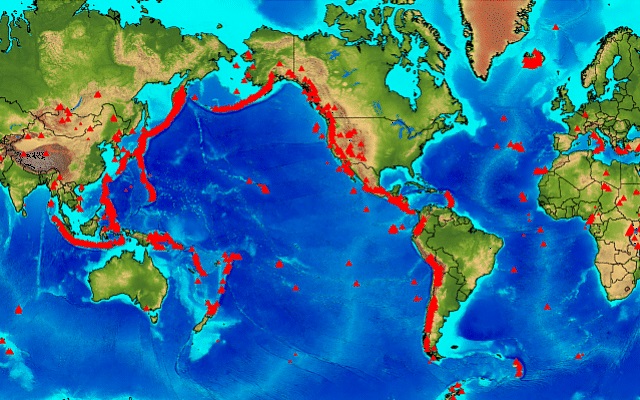
The similar area, the ring of fire, on Earth is covered in water, but if the water and sand can be removed around these mountains, we will find them connected directly to the lowland; no land barrier in between -- Basically, there is no major difference between the Earth and the other inner planets except water. And of course, the tectonic plates have nothing to do with the formation of mountains. The water on Earth is the factor that has played the major role that changed the Earth's surface features. And this could not have happened before the addition of rocks that created mountains and lowlands 200 million years ago.
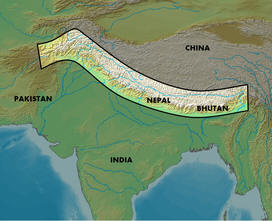
By looking at the way these mountains are laid, it seems that they were built along cracks in the continental crust, in a very similar manner as the Atlantic Ocean and other seas.
When comparing the lowlands and mountains of Earth with the lowlands and mountains of the other inner planets, we can see that the difference between cracks where mountains were built, and cracks where seas were created, is the timing. The cracks of mountains formed trenches in the continental crust at the time when the earth was receiving rocks from space, just like mountains on the other inner planets, whereas the cracks in ocean floor were stretched after water filled ocean basins.
At the time when rocks were falling from space, they fell either in trenches or on ocean floor, because of the high magnetic field in these places. The ionization of gases that was caused by gamma rays from the dying second sun created the magnetic field.
QUOTE: "Motion of an ionized gas will
produce a magnetic field."
stars.astro.illinois.edu
Since the falling rocks contain iron, and also magnetism, they were attracted to the nearest magnetic field.
The base layer of ocean floor is much larger than the base layer of trenches, so it took ocean floor much more time to build thickness and solidify.
Because the base layer of trenches is narrower, it solidified much faster.
Any rock that fell on ocean floor has broken through or melted, whereas rocks that fell in trenches have stacked up.

The picture of Mars above shows that some of the fallen rocks were stacking up together. The reason for these rocks to come together and then stack up is that they contain magnetism. Each rock was attracted by the one preceding it while they were coming down. On Earth, all rocky mountains have magnetism at various levels. It is very likely magnetism in mountain rocks was much stronger in the past than it is today.
The fallen rocks were not breaking because the iron core of Earth still hasn't developed yet; so the Earth gravity was very low; the rocks fall in slow motion.
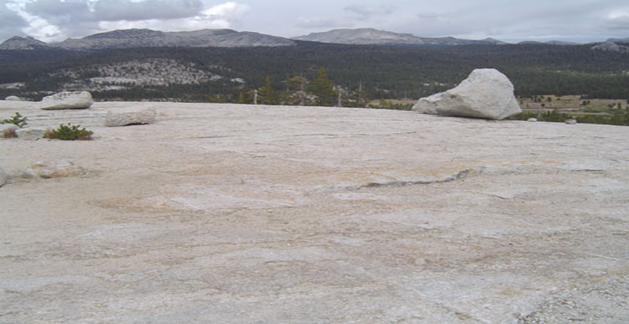
The dome in the picture above seems to be an uplifted area created by a rising magma. At a later time, when the surface was raised to a very high altitude, far away from the mantle heat, new rocks have fallen on it from the sky. Even though the rocks on this dome are very few, but they show that the Earth gravity was very low, otherwise the rocks would have broken.
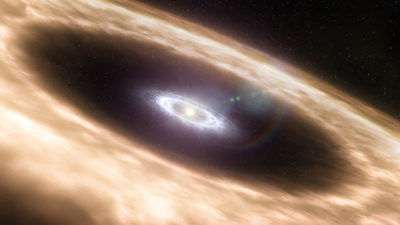
The presence of Earth materials, such as sand and mud, with mountain rocks indicates that they were mixed and heated together with moisture, but not heated to the melting point. This mixture may have been done in different ways. One way is by wind, like the picture of Mars above, but inside trenches. The wind blows on the surface of Earth and causes sand and dust from the top of the surface to fall inside trenches and between rocks. Another way is rain; the rain falls and drives sand and mud into trenches. Or, what looks like earth materials was actually dust came together with the rocks from the debris disk of the second sun. Or, a combination of all of the above mixed together.
Because mountains have their roots connected directly to the mantle, most volcanoes are found mainly in mountainous areas.

In the section about the Permian-Triassic extinction event, we talked about the huge rocks, that have fallen from the sky during the time of the extinction. This indicates that the falling rocks have something in common with the actual cause of the Great Dying. And since there were no rocky mountains on Earth before 200 million years, these huge rocks in Hungary, China and Japan add evidence to support that the rocks that make up mountains have actually come from space, at the time of the extinction.
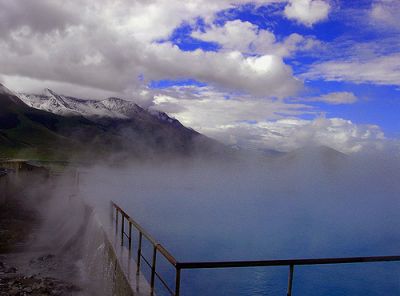
Most hot springs around the world are found in mountainous areas. The spring shown in the picture to the right is located at a very high altitude, about 4.5 km above sea level.
The heat that makes these springs hot is coming from the mantle. In fact, it looks like the water itself is coming from the mantle too; the very hot water vapor, H2O, that is coming from the mantle, which is the same as the water vapor that is produced by volcanoes, condenses into water liquid after making contact with colder mountain rocks. And this water liquid makes hot springs.
Hot springs that are found in volcanic areas are extremely hot, with temperatures at, or near, the boiling point. The presence of hot springs and volcanoes side-by-side indicates that they are coming from the same source, the earth's mantle.
It is very likely that steam like the one coming from hot springs existed in the past in all areas where mountains are found today. This hot steam, plus dust, sand and mud, formed the strong cement that glued mountain rocks.
The apparent reason for water vapor that makes hot springs to exist until this day is unsealed spaces in mountain structure.

Simplified block diagram for mountain formation
Based on what we have seen so far, it is very likely that mountains formed in a way similar to the simplified block diagram above -- The rocks that have fallen first inside a trench were fully melted, forming a near flat surface (A). Magma from the mantle raised the melted surface up. The rocks that followed stacked up together (B), but not melted because of the increased distance between the new rocks and the mantle. They formed a mountain hill. The rising magma kept pushing the whole block up (C).
 Since
the amounts of fallen rocks are not the same all the time, mountain hills are
not of the same height.
Since
the amounts of fallen rocks are not the same all the time, mountain hills are
not of the same height.
Not only the height is different, but also the directions of these hills are not the same. Some hills are going, for example, east-west, others north-south, and so on.
While the mountains were taking shape inside their trenches, high pressure magma from the earth's mantle kept pushing these mountains up, at various rates.. Some mountains were pushed up very fast, others much slower, and some others may still under ground, but covered with sand.. The different rising rates are due to the way the earth is adjusting itself with the new situation.
In some places, scratches on the surface of mountain hills are found (like the picture above). They are called fold-mountains. They look as they have been squeezed before they were pushed up. This could happen if their trenches were narrowed after mountain hills have already taken shape and solidified while they were below the surface of Earth.
Narrowing of trenches could happen if parts of the continental crust were pushed by ocean water.
It is written under the picture above that these mountains were raised about 70 million years ago. This shows that they have remained below the surface of the earth for a very long time, since the time of the formation of ocean floor until they were pushed up 70 million years ago.
14. What Causes Earthquakes?
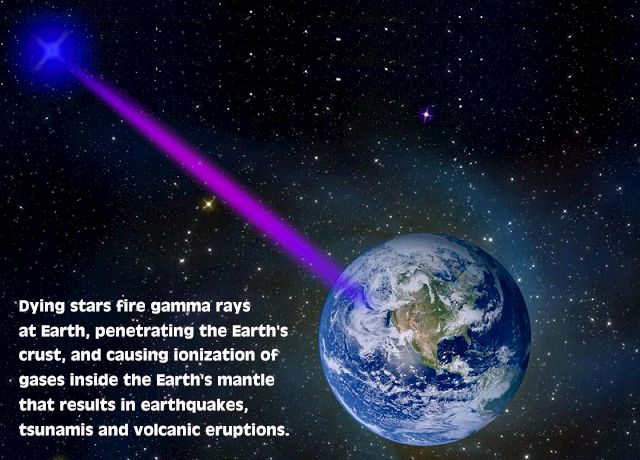
Earthquakes currently attributed to earth plates moving and clashing with each other.
The movement of earth plates is a result, and not a cause.
The factor that caused the earth's mantle to explode in the first time, that led to the Great Dying 200 million years ago, must be the same factor that causes these disasters on Earth nowadays. That factor is the energy that causes chemical reactions and expansion in the mantle's substances.
In the past, that energy was gamma rays fired by the second sun. Nowadays it is fired by distant dying stars, specifically pulsing stars (pulsars).
What makes the pulsar energy to go undetected is that the effect of this energy takes time to show up. Chemical reactions do not occur instantly.
A question may arise, if earthquakes are caused by cosmic rays from space,
and these rays can hit Earth anywhere, then why earthquakes happen in certain
areas only and not everywhere? The most likely reason is that the basalt layer
is very thin in the areas where earthquakes occur very frequently, so when dying
stars fire gamma rays at these areas, where the basalt layer is very thin, they
penetrate to the earth's mantle, and cause earthquakes in these weak areas, but
when they fire gamma rays at areas where the basalt layer is thick, the rays get
blocked by the thick layers and prevented from reaching the mantle.
Can Animals Sense Earthquakes?
Some animals sense earthquakes before they happen:
"In 373 B.C., historians recorded that animals,
including rats, snakes and weasels, deserted the Greek city of Helice in droves
just days before a quake devastated the place. Accounts of similar animal
anticipation of earthquakes have surfaced across the centuries since."
nationalgeographic.com

eqsigns.net
Even though the animals in the video clips reacted strangely to magnetic pulses, magnetism is unlikely the energy they sense to predict earthquakes.
The video clips show only a small group of animals. If a large group of different animals and birds are tested against magnetic pulses, will all of them show strange behavior?
The page on the link below and many other pages say all kinds of animals, birds, reptiles, and even insects can sense earthquakes!
"Animals, birds and earthquake predictions"
kiwitravelwriter.wordpress.com

egu.eu/news/
Smell is the only communication language of insects and reptiles.
Some birds, like homing pigeons, and animals, like cats and dogs, are also found having very strong sense of smell. But who knows, maybe all creatures, other than humans, can communicate, or identify things, via the sense of smell.

"Ants may have the ability to sense
earthquakes before they hit according to observations presented at the
European Geosciences Union annual meeting."
wired.co.uk/news/
The antenna on the top of ant's head is the sense organ of the ants. They use it to identify danger and finding food, and also to communicate with each other.
What we see here is that the sense of smell is the common factor among all creatures that can predict upcoming earthquakes.
When ionization of gases occurs inside the mantle, new gases are produced. One or more of these new gases, or gas mixtures, could be acting as a warning signal for animals, birds, and insects, and force them to leave their homes to places where the signal completely disappears.
Some people have tried to use the animal behavior as a precursor of earthquakes. But the animal behavior turned out a hit or miss! This is possible if the actual chemical reaction inside the mantle, and also the earthquake, is happening in a far place, tens of kilometers away from the city, in the sea for example, but its effect reaches the city and causes a disaster there.
Changes in Atmosphere
For centuries people have observed changes in the atmosphere prior to major earthquakes. Recent studies showed that the changes can reach up to the ionosphere, a layer in the atmosphere that starts at 80 km above the earth surface.
"These observations include: thermal infrared radiation;
radon/ion activities; air temperature and humidity, and concentration of
electrons in the ionosphere."
ntrs.nasa.gov
These atmospheric changes (that must be caused by gases interacting with air) are basically the same signs that signal animals to leave their places. But humans are not as good as animals in understanding the signs; so they correlate the signs with earthquakes only after earthquakes actually strike.
"Japan Earthquake Was 'In the Air' Days Before,
Scientist Claims"
livescience.com
The concentration of these atmospheric changes are found mainly above epicenters; areas where the basalt layer under the earth's crust is greatly damaged. This indicates that the gases that cause atmospheric changes (humidity, temperature, smell, etc.) are coming from the earth's mantle. So what can force gases to leave the mantle other than an increase in gas volume or pressure? And why do these gases get their volume increase in the first place? The most likely factor to cause this thing to happen is an ionization process taking place inside the earth's mantle. And if gas ionization is the case, there must be an ionizing energy inside the mantle.
Tsunamis and Earthquake Islands

Tsunami is a rise of sea water level. It is attributed to earthquakes happening under the sea that causes an uplift of a section of ocean floor.
Another possibility is ionized gases that are being released along major fault lines in the sea. These gases interact with sea water and create high and long water waves.
Of course, the sudden release of gases can also create an earthquake. But the earthquake itself is not the cause of tsunamis.
Some other earthquakes cause islands to form. Below are two examples.
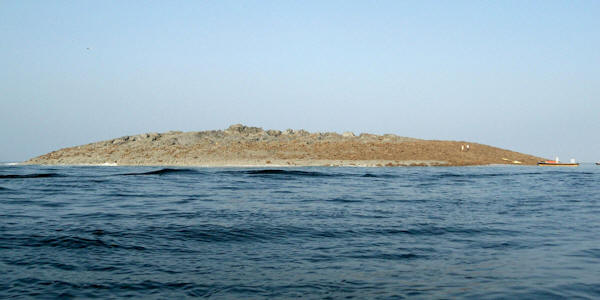
ibtimes.co.uk
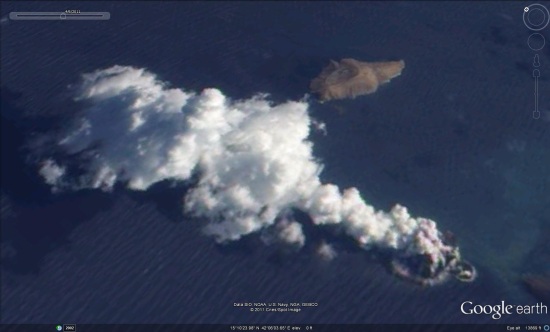
What can cause a piece of land to go up, other than a push, pressure, from bottom?
If there is something being lifted up, there must be something else lifting it from bottom. Based on this simple logic, there is nothing we can see that can raise these islands, other than the gases that are also coming out of the nearby volcano, in the picture above.
Regarding the Pakistan earthquake, that island was also an ancient volcano!
In both cases, in Pakistan and the Red Sea, we find the gas as the common
factor.
Earthquake Lights
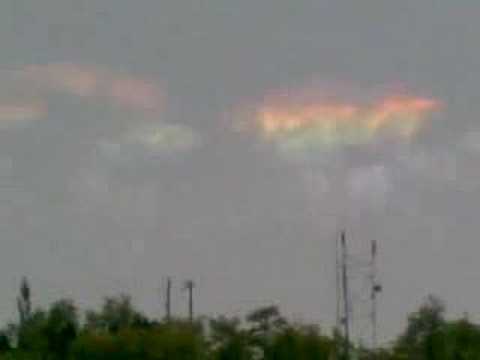
youtube.com
The picture to the right is of a China earthquake. The sky has changed color in a far distant place. After 30 minutes, a quake struck in a different area.
Based on what is seen in this picture, these strange clouds seem to be rising from the ground.
It seems that ionized gases from the mantle interacted with air particles in the sky and formed new substances that look in color like rainbow. It is possible that the ionized gas particles in the mantle continued to move forward until it reached a major fault line and caused a disaster there, or the earthquake could have been caused by another and bigger ionization process took place in the area where the earthquake struck.
These strange clouds are called Earthquake Lights. It is mentioned on the
link below that the so-called earthquake lights: "have been accompanied by
low-frequency radio noise in the
10 to 20 kHz
range. Earthquake lights have been seen weeks before or after earthquakes and
hundreds of kilometers from the epicenter."
geology.about.com
youtube.com
In addition to the dangerous energies pulsars emit, they also generate frequencies in the range of human hearing, roughly between 20 Hz - 20 kHz. This frequency range is almost the same as the range of frequencies mentioned in the quote above.
If this range of frequencies is converted to sound, it can be heard. The video on YouTube on the link under the picture to the right is an example of this conversion.
It might be possible that the pulsar sound, if studied properly, in correlation with other energies the pulsar emits, to be used as an early warning signal for earthquakes and other natural disasters!
It doesn't seem there is any recording of the earthquake frequency mentioned in the quote above published on the web, but even if a recording of this frequency does exist, it is unlikely to be as clear as the sound recording found on YouTube, because the recording must have been done on Earth, and that frequency range cannot penetrate the Earth atmosphere without severe distortion. However, if it is possible to filter out distortions and noise from the recording, a tone very close to the one found on YouTube might be recovered.
It is also mentioned in the quote above that these clouds have been seen
sometimes "before" and sometimes "after" earthquakes, and hundreds of kilometers
away from the epicenter -- Now we do not have a clear picture of what is
happening inside the earth's mantle, so we don't know whether these same ionized
gases have created clouds in one area and then continued to move to a different
area where they created an earthquake, or they are separate strikes of gamma
rays on different areas; in one area they have been attenuated too much by the
basalt layer, so they created a little ionization in the mantle gases that
resulted in earthquake clouds, whereas they have not been attenuated that much
in the other area where they have caused an earthquake. But regardless which
assumption is correct, or maybe both, the point is that an ionization process is
happening inside the earth's mantle and resulting in strange clouds and
earthquakes.
Volcanic and Earthquake Lightning
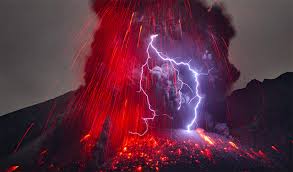
Volcanic Lightning is very similar to rain lightning. Both are created when an electrically charged region discharges suddenly into a negative region of air or the ground.
There is also a phenomenon called, Earthquake Lightning. This is different from the Earthquake Lights mentioned earlier:
"In some parts of the world, earthquakes are often accompanied by ball lightning, stroke lightning and sheet lightning." (nature.com)
The presence of charged, positively ionized, particles in volcanic gases and
earthquakes shows that an ionization process is taking place inside the earth's
mantle, before, during, and after, the time of earthquakes and volcanic
eruptions.
Earthquakes and Magnetic Field Fluctuations
Earthquake researchers in Japan and Taiwan have observed fluctuations in
magnetic field on the surface of the earth, prior to, and at the time of, major
earthquakes.
terrapub.co.jp
As mentioned in another section, moving ionized gases create a magnetic field.
QUOTE: "Motion of an ionized gas will
produce a magnetic field."
stars.astro.illinois.edu
The magnetic field created by the positively charged gases inside the mantle must be very, very strong, in order to cross the land crust and cause magnetic fluctuations on the surface of the earth.
In a similar phenomenon, "rain" lightning creates a magnetic force of a very
great magnitude. Sometimes it causes fluctuations in electricity and introduces
noise in electronic communications and radio channels. So there is no difference
between rain lightning and earthquake/volcanic lightning, or the magnetic field
introduced by both.
Forecasting Earthquakes and Related Natural Disasters
We have seen in the previous paragraphs some signs and examples of earthquakes and the like. Every single sign and phenomenon must be taken into consideration before making any conclusion. The common factor for all the signs that have been presented in this section is the gas.
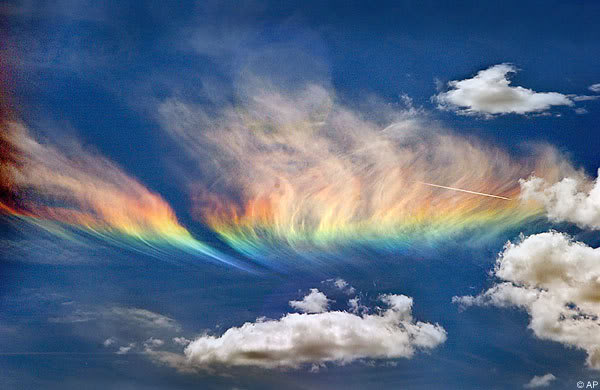
But where to watch for the ionization of gases? In the sky? Of course not. Not all animals are in the sky, but all of them sense earthquakes before they happen. The one and only one place that is known for releasing gases is the earth's mantle. Fortunately, we do not have to dig to the mantle in order to identify the gases available there. The mantle is releasing these gases via cracks (fault lines), and volcanic craters.
One way to test for the gas that acts as a warning message to animals is to take samples of volcanic gases and ionize them inside a laboratory with gamma ray, in the presence of animals, birds, reptiles, and insects. Gas sensors for all kinds of gases, and gas level indicators, have to be installed. Nerve instruments have to be mounted on the bodies of the animals under test. Experiments and good analysis of results should lead to the identification of the gas that acts as an earthquake sign.
Experimenting with ionization of volcanic gases and direct gamma or neutron ray strikes with air and very thin water vapor in order to produce earthquake lights, the lights that look like rainbow. Although this is a very difficult experiment to make, it is very important, because it gives a visual result.
Even though magnetism is not the cause of earthquakes, and changes in the magnetic field will not make colors of clouds in the sky to look like rainbow, but it can be used as a sign. Moving ionized particles generate a magnetic field. The presence and direction of magnetic pulses should be detectable by sensitive magnetic sensors. The data from these sensors will let people watching for earthquakes to know where the ionized gases are heading, at what speed, and on which major fault line they will strike. Magnetic sensors are to be used with gas sensors to avoid false indications.
Frequency meters for measuring and monitoring the range of frequencies from 10 Hz to 20 kHz are also required. The antennas of these meters/recorders should be mounted above mountains, in places where the noise level is very low. The result must be studied in correlation and comparison with pulsar frequencies.
The above ideas may not be sufficient for forecasting earthquakes accurately. But if they are taken as basis, and tested properly, and the results are analyzed correctly, they should lead to new ideas, ways, and procedures, which will result in accurate forecasting of earthquakes and other natural disasters.
15. The End of Life on Earth (The Final Extinction Event)

An imaginary painting of an extinction event
We have seen in a previous section that some stars at the end of their life fail to convert gamma rays to light; and instead of giving light, they fire very powerful gamma rays.
The dead sun was from the same family that the current sun belongs to. They both were born together, grown together, and made from the same chemical composition. So it is expected that this sun, at some time in the future, before the end of its life, to fire gamma rays at earth. But unlike gamma rays that hit the earth nowadays from distant stars, the sun is a very near star, so the effect will be devastating.
At that time, earthquakes of very huge magnitudes will take place everywhere. The earth will be torn apart. Pressure of gases inside the mantle will increase dramatically causing the earth to expand and mountains to collapse.
Countless number of small islands, like the ones we have seen in the pictures of Pakistan and the Red Sea, will be formed.
Tsunamis will happen very frequently. Volcanoes will throw rocks of very huge sizes; destroying buildings, roads, and anything they hit. Those volcanoes will not be limited to the Ring of Fire only, but will cover the entire earth.
Even though the second sun was from the same family as the current sun, the two suns are not exactly the same, and that is why one of them already died while the other is still alive. According to theory, the main sun will expand as a red giant up to the orbit of Earth; and it will consume Mercury, Venus, the moon and Earth; and then it will shrink as a white dwarf. This scenario cannot be ruled out, but if it happens, it will be only after the events mentioned above.
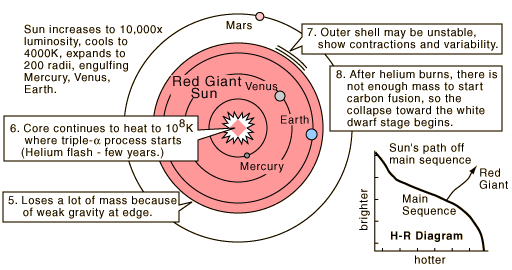
hyperphysics.phy-astr.gsu.edu
The second sun caused the so-called Great Dying, and the current sun will cause the same. It is the final extinction of life on Earth. That is the END.
16. Conclusion
Many theories have been formulated to explain natural phenomena on Earth and Space. The high temperature of the early Earth is attributed to the presence of extra carbon in the Earth's atmosphere. The short day of the early Earth is attributed to fast rotation of the earth. The seafloor is said to be recycling every 200 million years. The source of rust on Mars is still a mystery. The lowlands on the other planets are another mystery. And the list goes on.
However, no traces of high carbon level on the earth are found, or signs of any abnormal rotation of the early earth. None of the given theories are supported by evidence that can be seen or verified.
The question now is, if there were another sun and died out, wouldn't it produce all of these results? If the answer is yes, and it is, so there had to be another sun in the sky. Its remains are still there and can be evaluated.
Knowing what has happened in the past isn't only good information to have, but also helps solving problems occurring today and predicting the future. It may not be important for many to know whether a second sun existed or not, but certainly everybody cares about earthquakes and other natural disasters.
The effect of the second sun on the earth in particular, and on the solar system in general, is a very large topic. We have only touched the surface. In-depth analysis and details are far to cover in few pages. But hopefully the main points presented in this report have given an overall idea of the role that the Night Sun has played.
